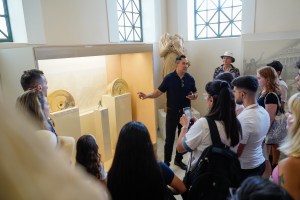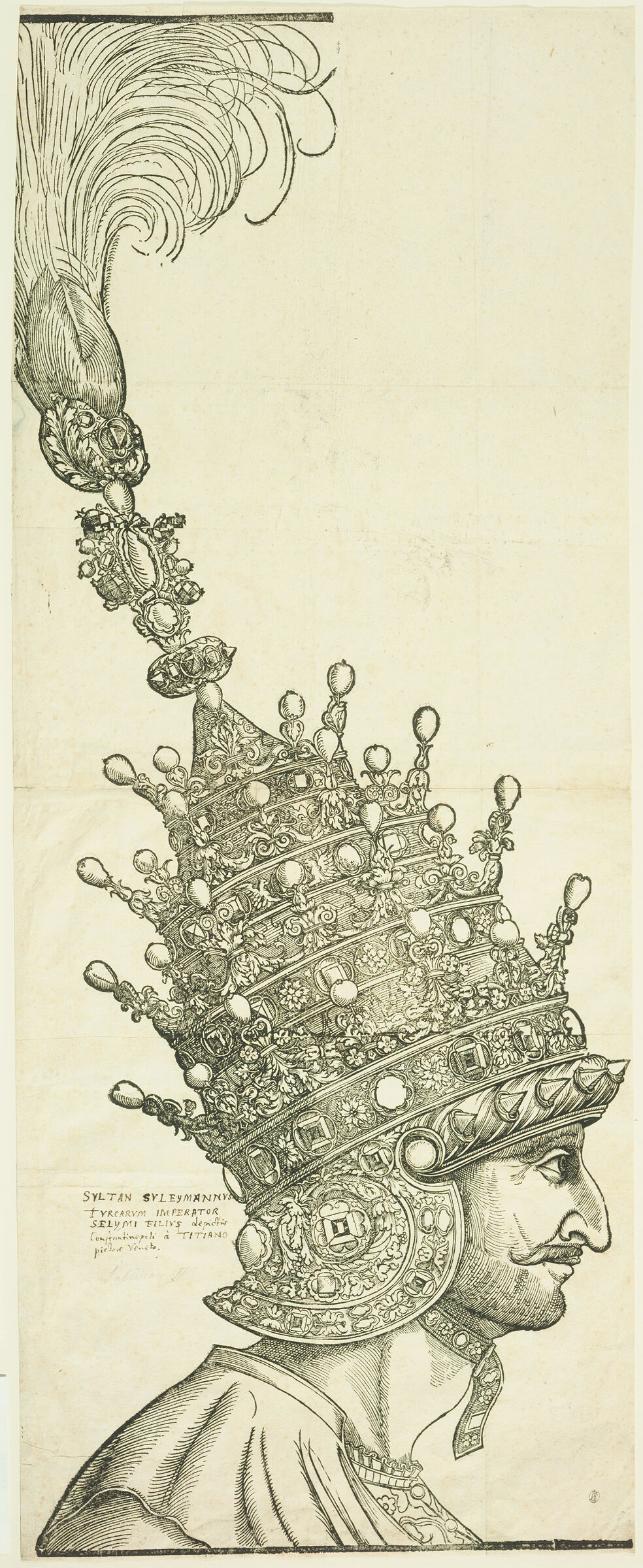We know about the wars. What about the flowers?
Excerpted from “Customs and Fashions of the Turks,” Pieter Coecke van Aelst, 1553.
Fogg Museum; video by James Byard/Harvard Staff
Exhibit tracing multicultural exchanges over three centuries finds common threads and plenty of drama, from crown envy to tulip mania
When it came to crowns, Sultan Süleyman’s four-tiered marvel put Charles V’s — and even the pope’s — to shame. At meetings with Habsburg ambassadors in the 1530s, the Ottoman leader would place the plumed, jewel-studded helmet in front of him to flex his universal sovereignty.
The sultan’s actions were all too human — a perfect fit with many of the stories behind the featured objects in “Imagine Me and You: Dutch and Flemish Encounters with the Islamic World, 1450-1750,” on view at the Harvard Art Museums through Aug. 18. The diverse cultures in the Low Countries and the Islamic world mesh more than they clash in the exhibit, through fashion, furnishings, and a frenzy for tulips. That’s the point, says curator Talitha Maria G. Schepers, the museums’ Stanley H. Durwood Foundation Curatorial Fellow.
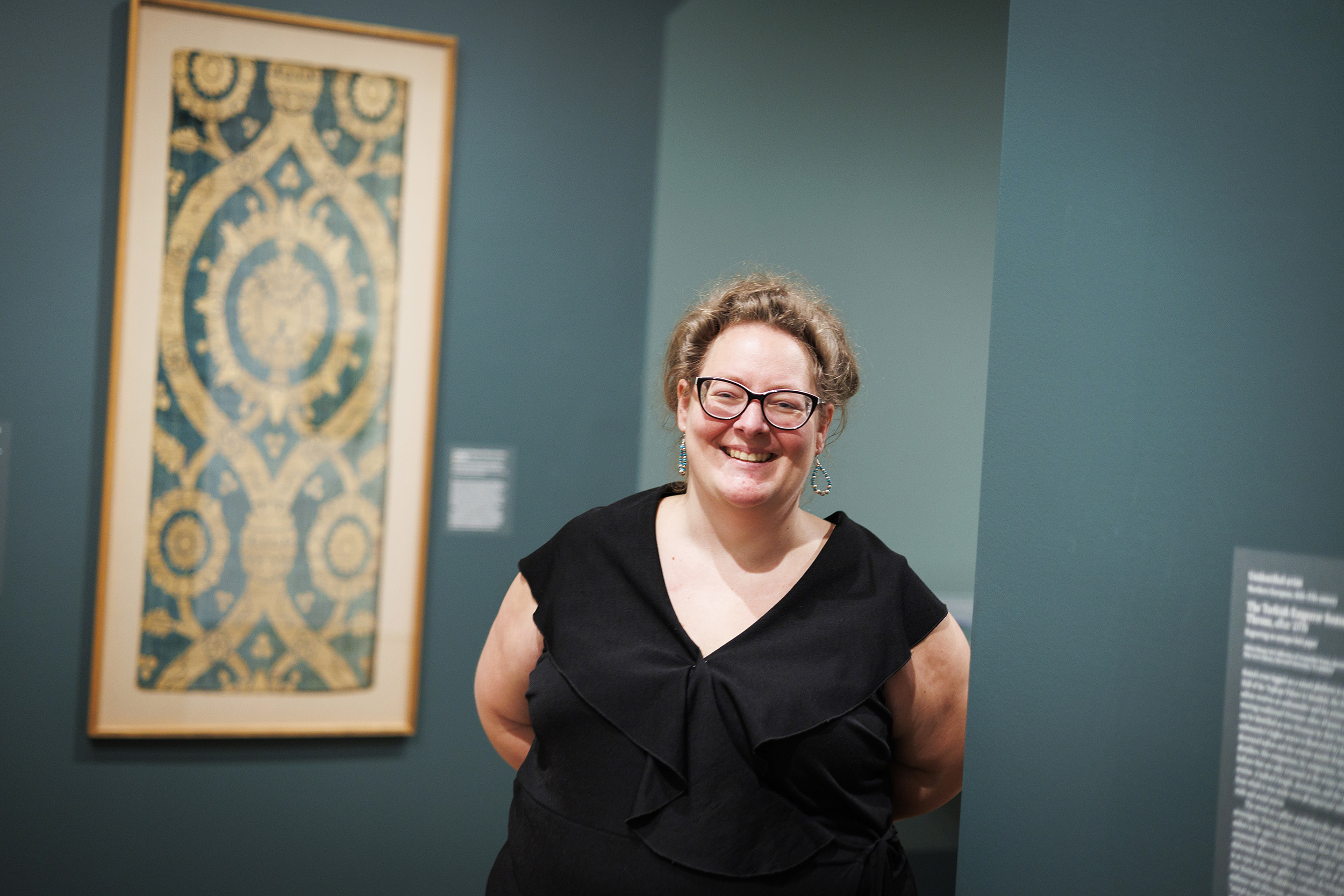
Curator Talitha Schepers’ dissertation inspired the exhibition, which she named after the lyrics of The Turtles song, “Happy Together.”
Stephanie Mitchell/Harvard Staff Photographer
“In the past 100 years, most exhibitions have focused on fear and fascination, and it’s always Christians versus Muslims, and always war, war, war. That’s not the whole story,” said Schepers, the Stanley H. Durwood Foundation Curatorial Fellow. “There were many more cultural exchanges. So this exhibition does the complete opposite,” focusing instead on trade, travel, and diplomacy.
In a tour of the exhibit, Schepers talked about the people behind the objects, with a focus on their social aspirations. Status-seekers paying the price of a house for a flower; brides boosting their height and prestige by wearing shoes impossible to stand in without servants’ help; an artist chronicling, in a 16-foot frieze, the feasts, funerals, and other scenes of everyday life he witnessed on a trek from Antwerp to Istanbul.
Tulip mania
“Tulipomania is the first speculative craze in Europe, or the first one we know of,” said Schepers.
Tulips originated in Central Asia, then arrived in the Ottoman Empire, where Habsburg ambassador Ogier Ghiselin de Busbecq, a keen gardener himself, encountered them. He reportedly introduced them to Europe, laying the groundwork for tulipomania.
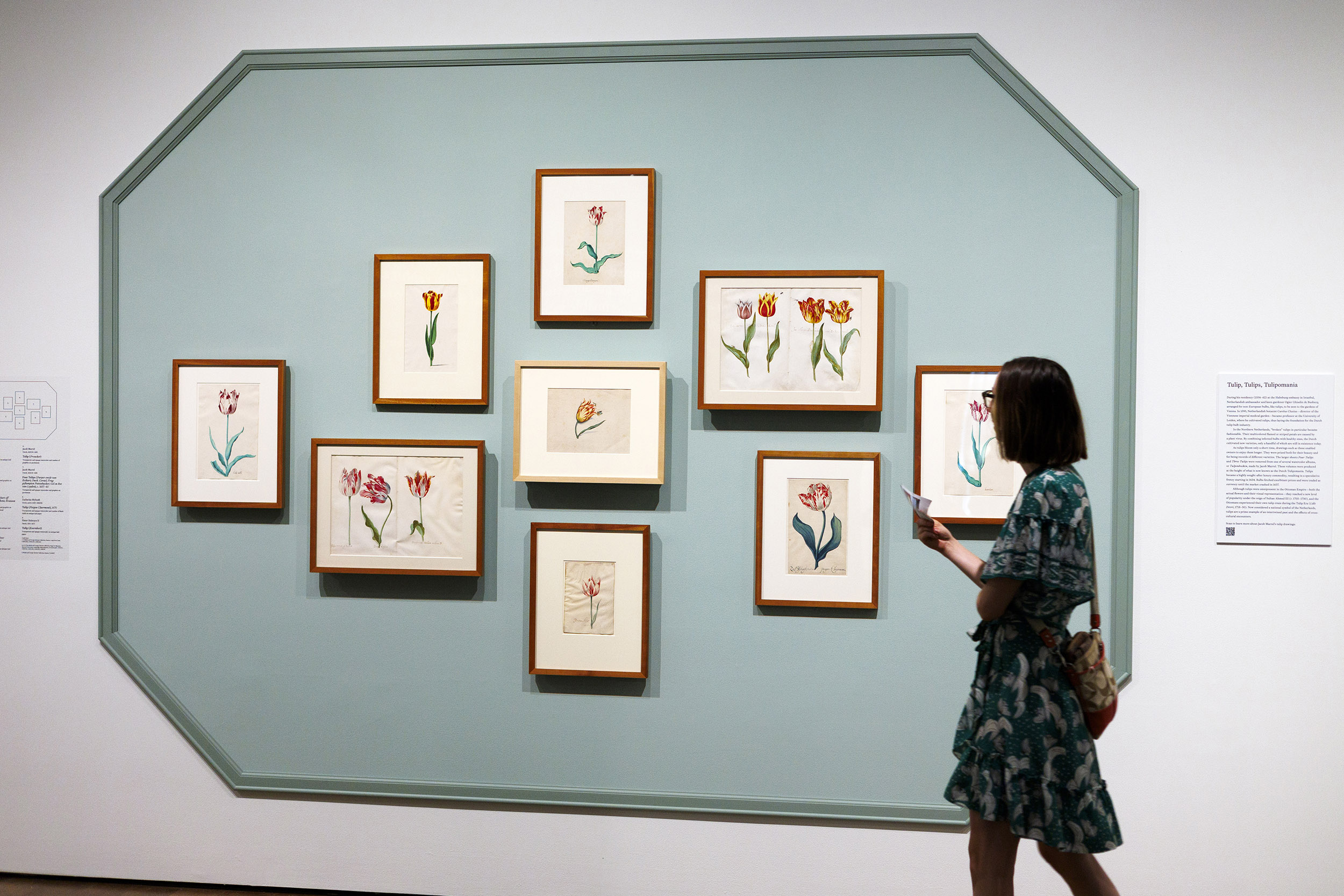
A visitor takes in a framed grouping of tulip drawings. A work by Margaretha Adriaensdr. de Heer, the only female artist on the wall, pops out in the center.
Stephanie Mitchell/Harvard Staff Photographer
Flowers grown in the Dutch Republic took on a new look, with multicolored flamed or striped petals. “The stems get longer and suddenly we have all of these patterns, and that’s because of a virus that was called ‘broken tulip virus,’” Schepers said.
At the height of the speculative craze in 1637 before the market crashed, the price of one tulip bulb fetched 1,000 florin (guilders), the price of a modest house in the Dutch Republic at the time, she said.
Comparison of prices in January 1637 (height of craze)
For 1,000 florin you could buy one tulip bulb or…

A modest house.
Illustrations by Liz Zonarich/Harvard Staff; source: Harvard Art Museums
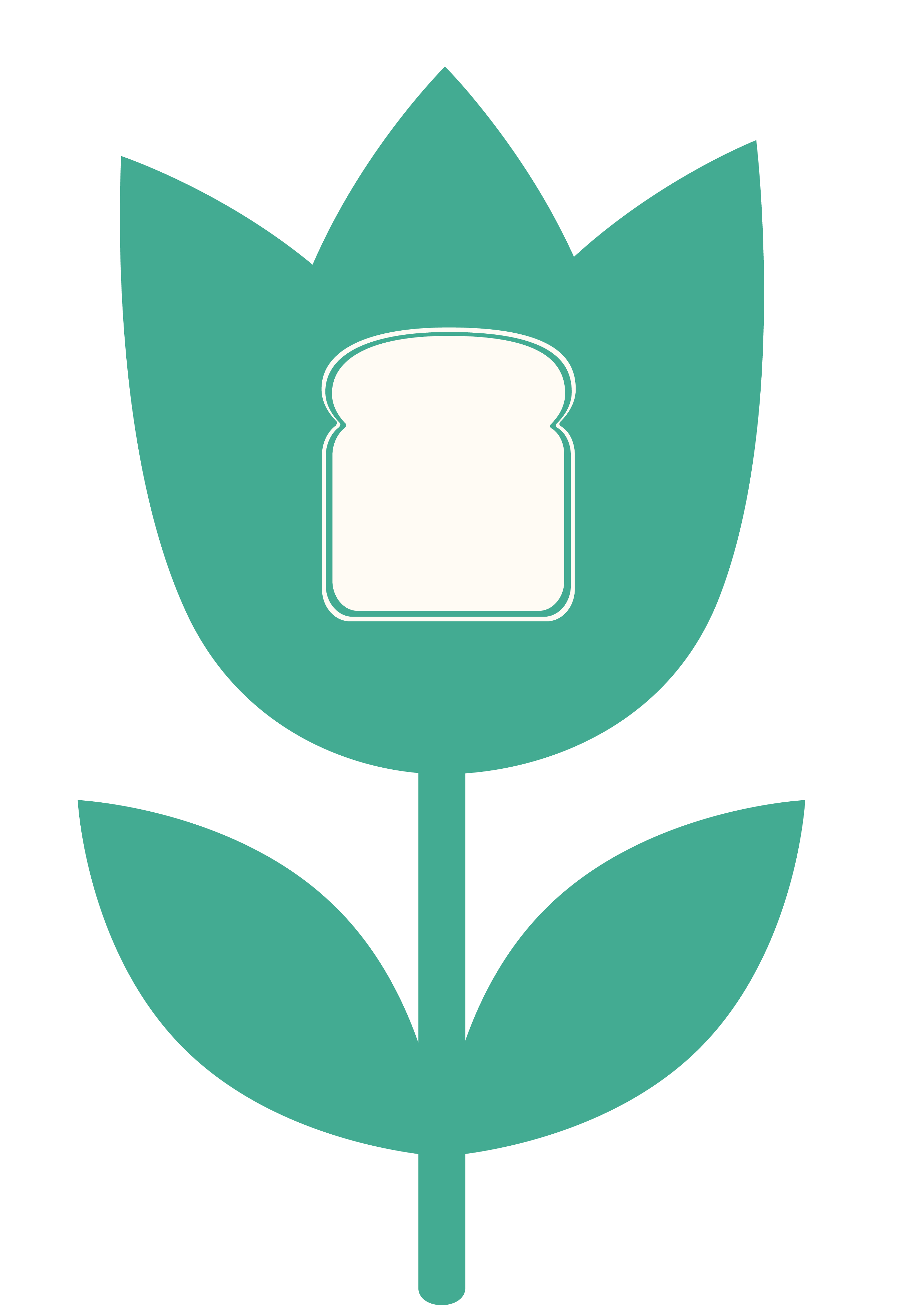
11.587 kilos of rye bread.
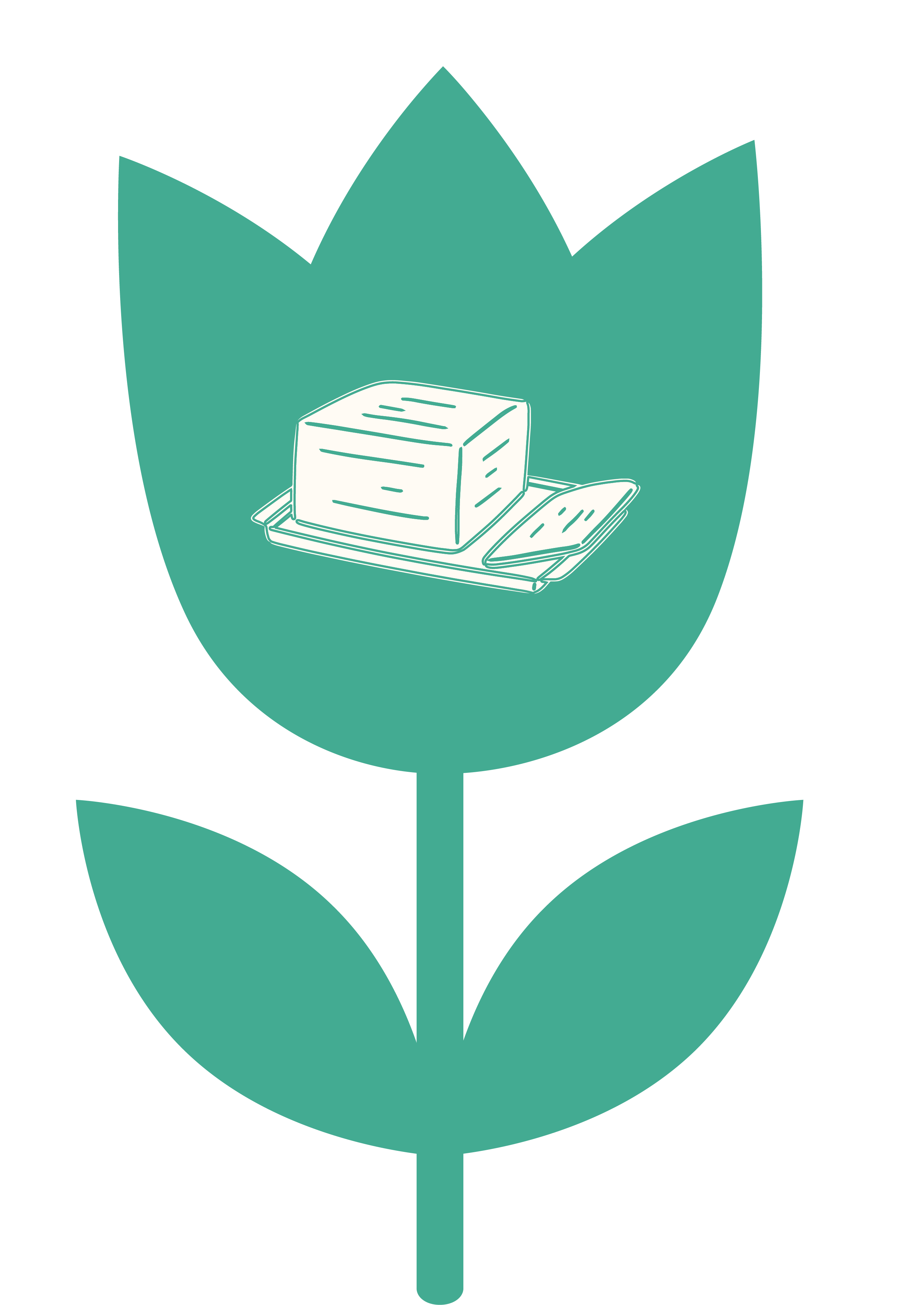
13.4 vats of butter.

5,714 pounds of meat.
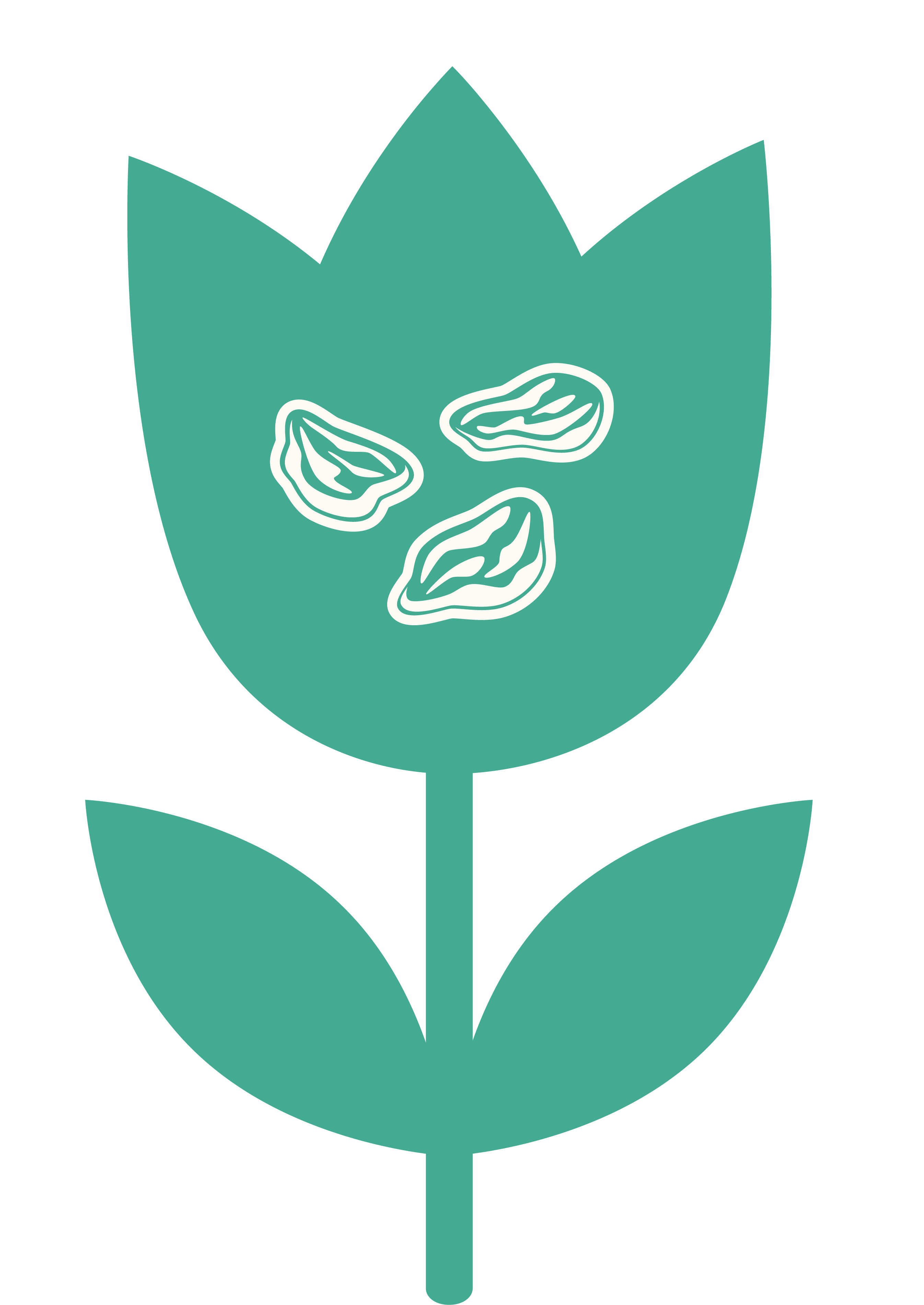
5,633 pounds of raisins.
Buyers usually ordered the tulips before they bloomed, which caused lawsuits even before the market crash due to the unpredictability of the virus. Imagine paying that kind of money and not getting your preferred color? “There are court cases of people being angry after paying crazy prices but the tulips didn’t look like the ones they wanted,” Schepers said.
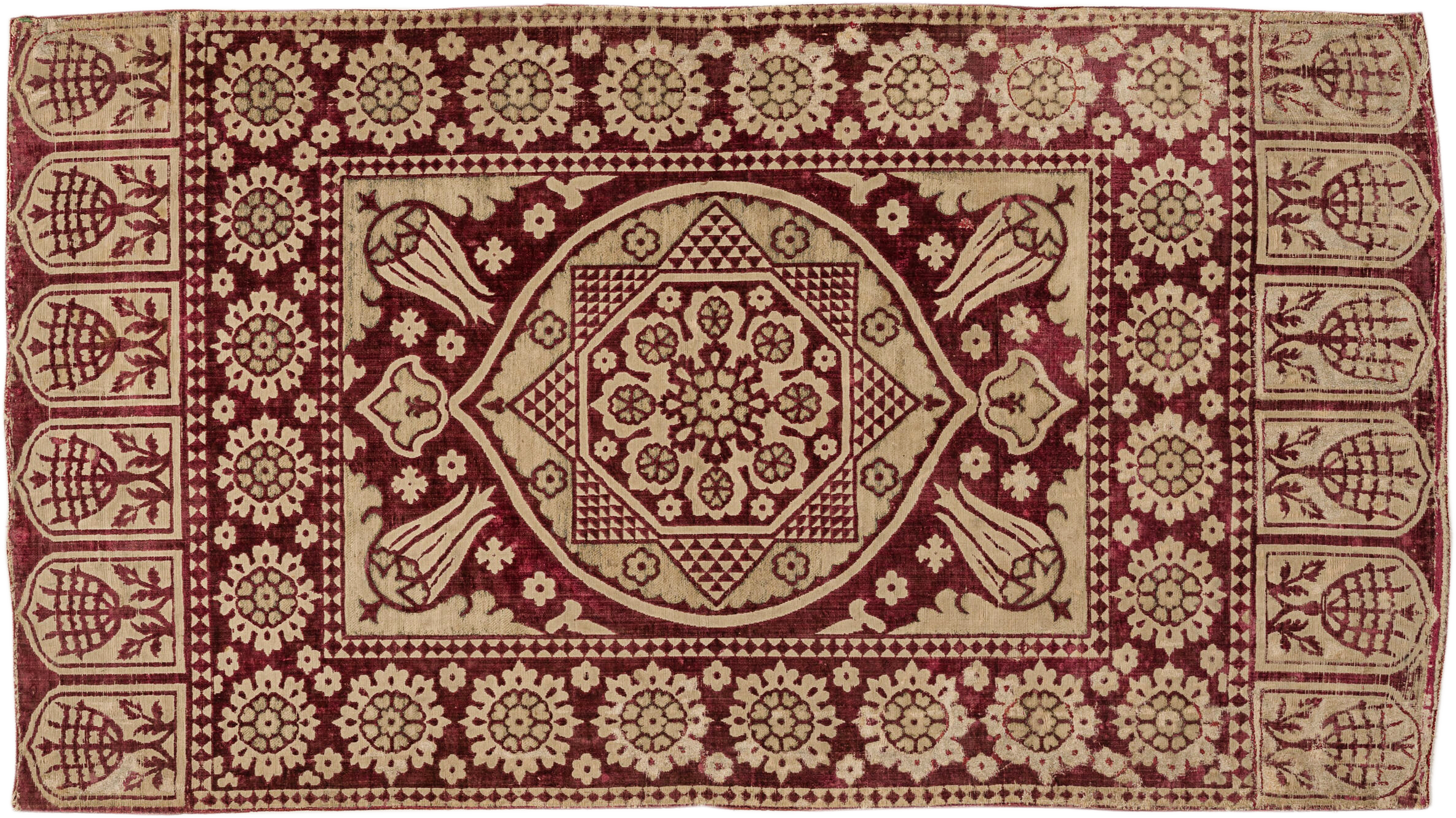
Velvet cushion cover, Turkey, c. 1675–1725.
Arthur M. Sackler Museum
Ottoman textiles from the period also show tulips, including “this gorgeous 16th-century Ottoman cushion cover” (above), which Schepers insisted be displayed as it would have been in the homes of wealthy Ottomans, on a low sofa. It’s rare for the museums to show such items outside a protective case, but the curator said it was important for visitors to be able to experience these objects in their original context.
Antwerp to Istanbul: A visual travelogue, 1533
“In 1533, Pieter Coecke van Aelst, an Antwerp artist, travels to the Ottoman Empire,” said Schepers. “He probably went with Cornelis de Schepper, a famous Habsburg ambassador. We think they traveled together because at that time it was very rare for people to travel to the Ottoman Empire, so if you go with a bigger retinue you get more protection.”
Coecke documented his journey in a 16-foot frieze containing seven scenes separated by decorative caryatids.
‘Customs and Fashions of the Turks,’ scene-by-scene
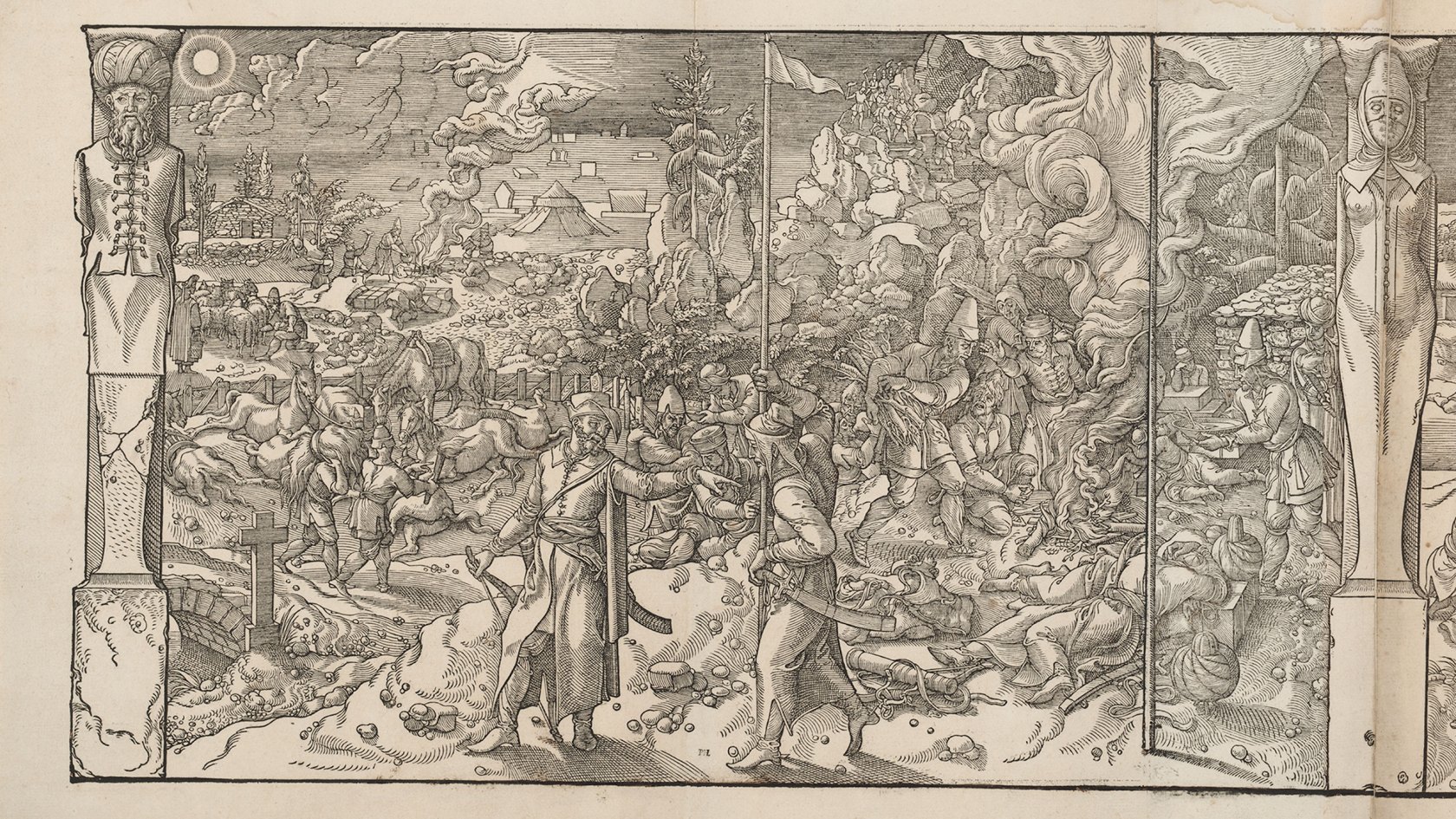
The frieze begins as the diplomatic retinue sets foot in Ottoman territory. Any diplomatic mission would have been joined by Ottoman soldiers who would safeguard the group until it reached Istanbul. Here, soldiers navigate the mountainous terrain of Slavonia. In the foreground, a soldier gives instructions to a lower-ranking official carrying a flagpole. At lower right, higher-ranking members of the group are already asleep for the night, their turbans resting beside them.
“Customs and Fashions of the Turks,” Pieter Coecke van Aelst, 1553. Fogg Museum; source: Harvard Art Museums
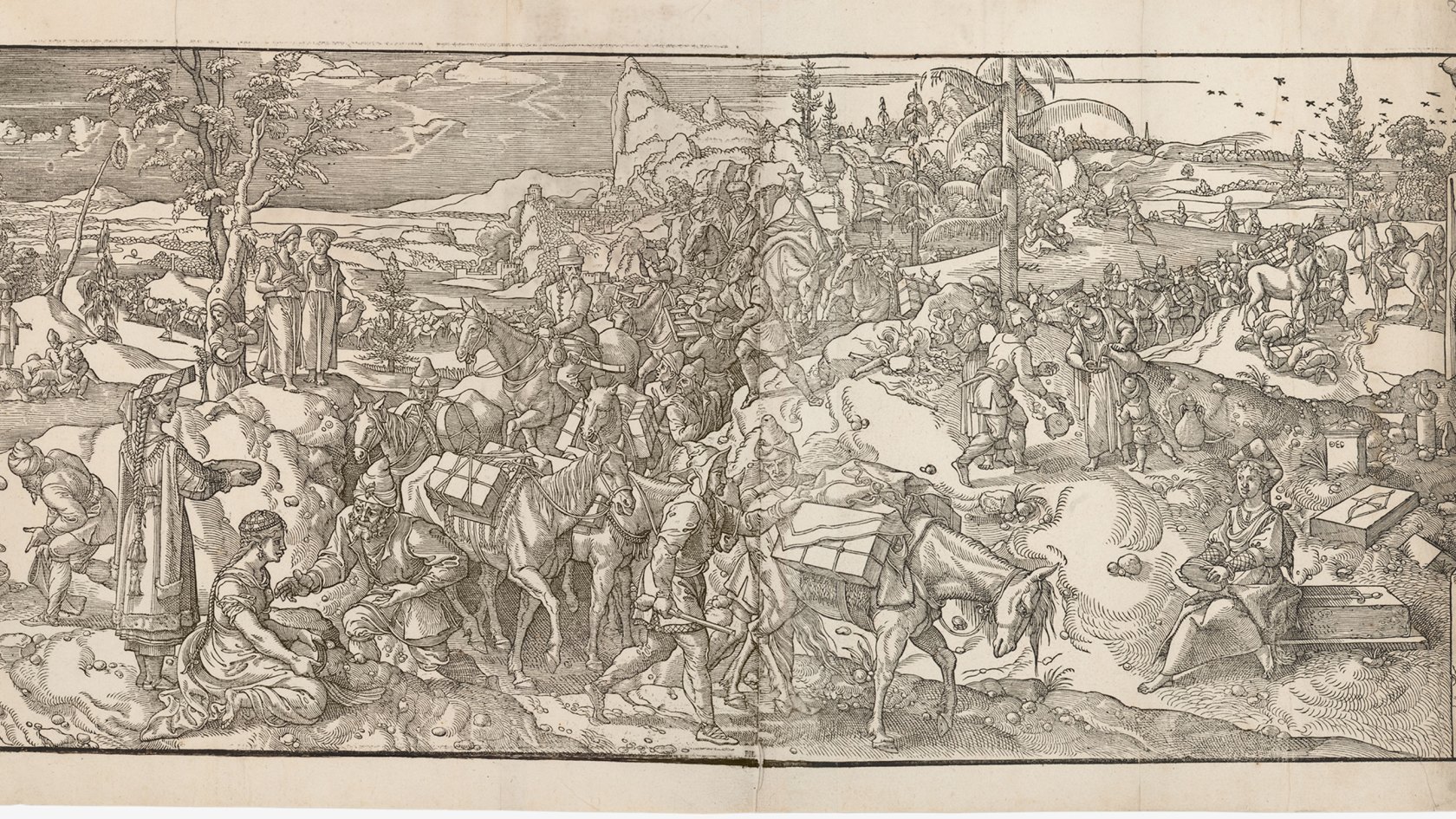
The retinue continues at the break of day. Several women dressed in traditional Eastern European attire are selling bread and water to the travelers. According to Habsburg ambassador Karel Rym, unmarried Bulgarian women kept their hair very short until their wedding, after which they would let it grow as long as possible. The woman standing at left in the foreground seems to have been married for quite a while, as she has to tuck her long braid behind the sash around her waist to prevent it from trailing.
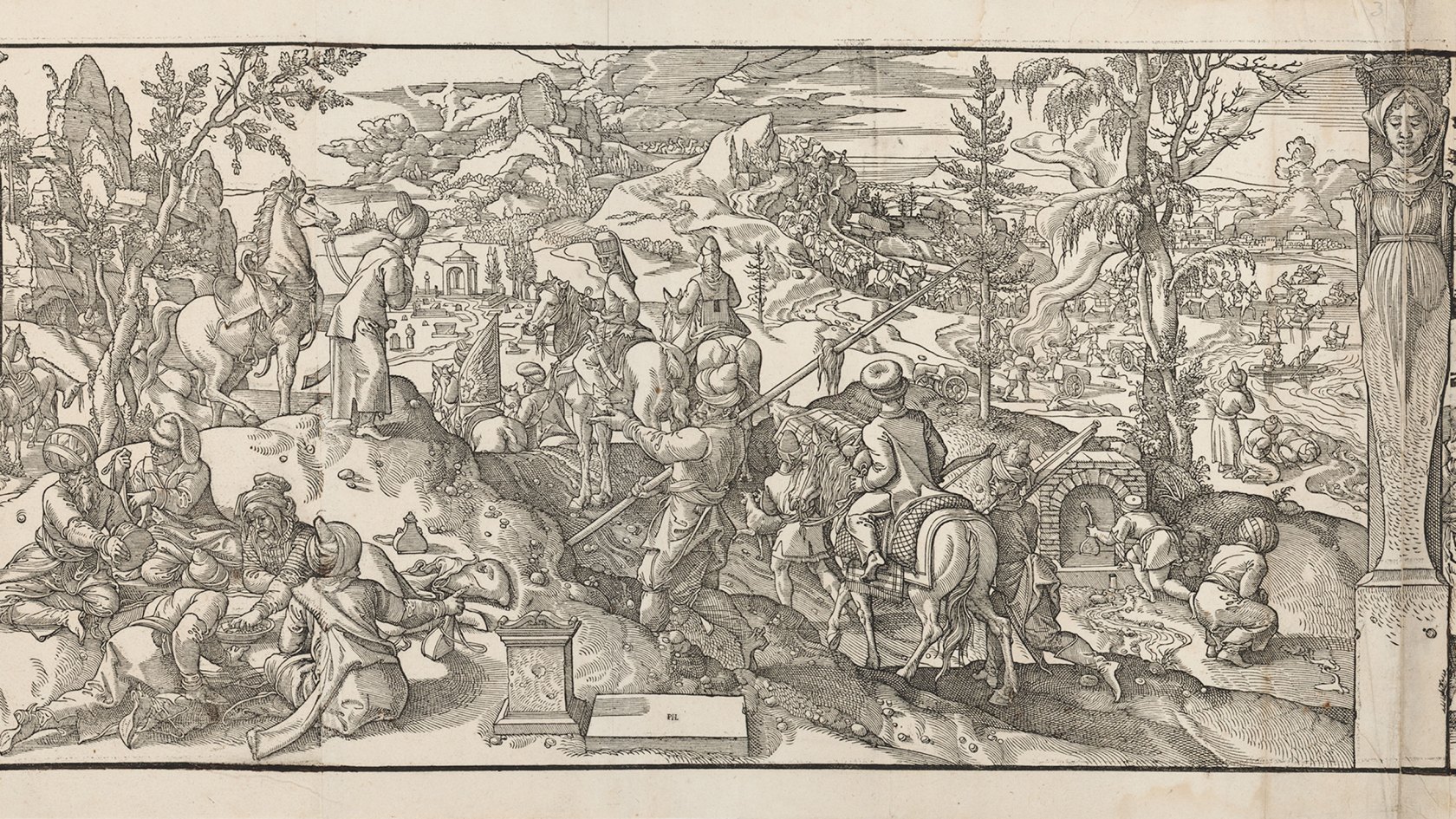
A procession of packed camels and horses crosses the mountains in the background, while a variety of everyday Ottoman customs take place in the foreground. A group of men share a meal seated on the ground; others are shown greeting each other, buying water from local women, or praying near the water. One man, at far right, can even be seen relieving himself. Prints like this would satisfy audiences in the Low Countries who were curious about everyday Ottoman practices.
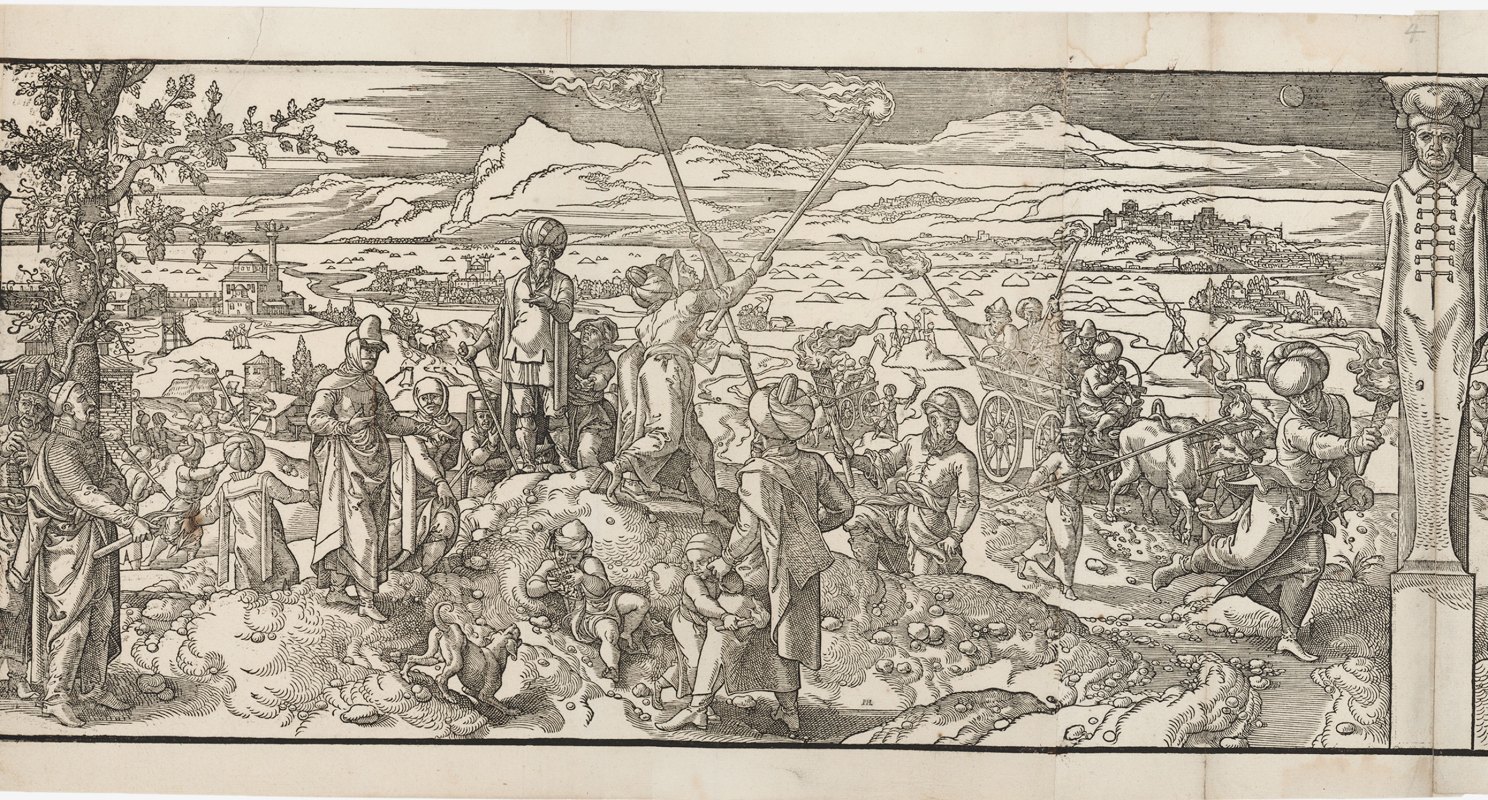
An Ottoman soldier at far left directs our gaze as he observes the celebration before him. The French inscription (missing in this impression) specifies that in Macedonia, “The Turkish inhabitants, at the first view of every new moon of the whole year are delighted.” The Ottomans followed the Muslim lunar (Hijri) calendar. Ambassador De Schepper wrote that on July 3, 1533, he witnessed celebrations at nightfall that lasted three days. According to the Hijri calendar, July 3 was the first day of the Eid al-Adha.

We now witness a solemn funeral procession. Children carry saplings that would be planted near the grave. The original French inscription explains that men would climb into these trees every year. The soul of the deceased buried underneath the tallest tree has the greatest glory. Throughout the frieze, several cemeteries are shown in the background. The changing tombstones indicate the traveler’s progress into Ottoman territory: The closer we get to Istanbul, the more Ottoman gravestones (with carved turbans on top) appear.

A circumcision procession is led by men playing the zurna (a wind instrument), davul (drums), saz (an instrument like a tambour), and zil (cymbals), while women and children bring up the rear. According to De Schepper, after their circumcision the boys will swap their conical hats for their first turbans. We have finally reached Istanbul. The background is a view across the Golden Horn to the old city, with the mosque of Mehmed II in the middle and the mosque of Selim I to the right.
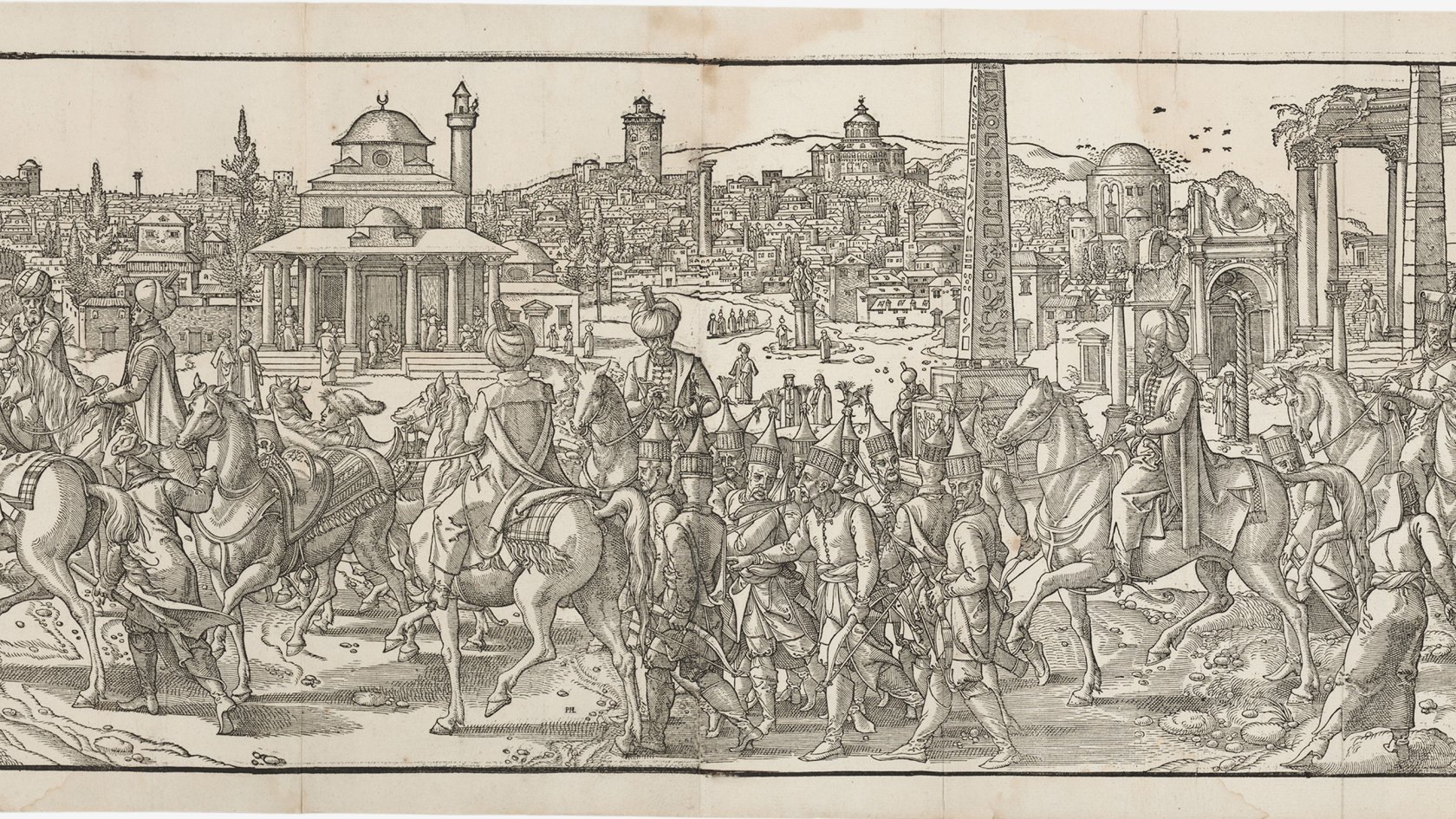
Coecke’s journey to Istanbul concludes with a ceremonial procession of Sultan Süleyman — seen here in profile on horseback, close to the right edge of the scene — from the Hippodrome to a mosque, possibly the Hagia Sophia. The sultan’s weekly procession to the mosque was an opportunity to exhibit the military strength and wealth of the palace to foreign visitors. Rather than an accurate topographical view, Coecke gave a composite view of the Hippodrome that allowed him to include more landmark monuments.
“What I love about this is the humanity of the scenes, like this kid is playing the flute,” said the curator, referring to Scene 4, “but this other kid is clearly scared and then he almost sets fire to the rope of whoever’s guarding him. There are lots of tiny details like that in it which makes it very approachable.”
Top that
“You can see from the print that the real topic is the crown, not the sultan, who is basically almost shrunken underneath it,” said Schepers. “Now the fun fact is that this crown has four layers, so it’s one tier higher than the papal tiara and it is larger than Charles V’s crown, so he’s basically saying, ‘My crown is bigger than yours.’”
According to Schepers, Grand Vizier İbrahim Pasha commissioned the helmet through Venetian merchants to visually legitimize Sultan Süleyman’s claim as a universal ruler. The print, on loan from the Museum of Fine Arts Boston, is a fictitious representation, she said; the unknown artist likely glimpsed the helmet-crown while it was displayed in Venice before it got shipped to the Ottoman Empire.
“The sultan would have never worn a crown because wearing a crown means you have to take off your turban, and you would never do that as a ruler. But the helmet-crown did exist.” Records of it stop after the 18th century, said Schepers, speculating it “probably got melted at some point.”
Hip saint
Netherlandish artists, like Adriaen Isenbrandt in the oil painting below, often rendered biblical figures in contemporary fashion and interiors to make them relatable, said Schepers.
“You look at this as a woman, you see your clothing, you see your fashion, you see your house, wooden paneling, the stained-glass windows, and you recognize yourself in the scene. You can immediately identify with St. Catherine.”
Not literally, the curator jokes. “This is a mystic marriage. She’s not really getting married to a baby. She’s promising herself to Christianity.”
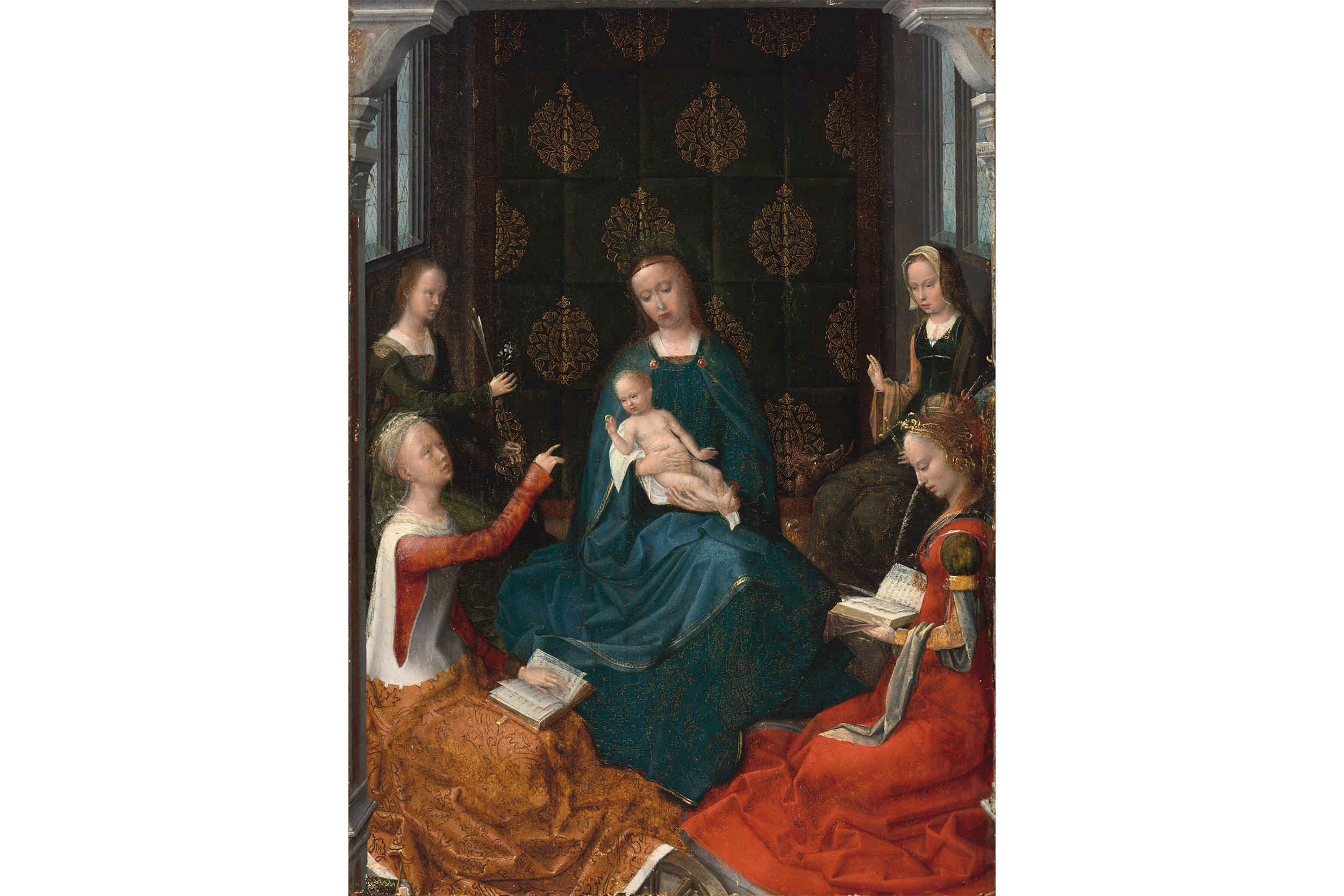
“The Mystic Marriage of Saint Catherine of Alexandria with Three Female Saints,” Adriaen Isenbrant c. 1520.
Fogg Museum

“Velvet with Tulips and Carnations in Ogival Lattice,” c. 1550–1650.
Arthur M. Sackler Museum
The drapery in the painting has a similar motif to the Ottoman silk velvet placed with it. Europeans considered such textiles luxury goods at the time, Schepers said.
“All of the darker bits,” she added, pointing to the fabric. “That’s actually silver that was tarnished over time, so it would have been way brighter.”
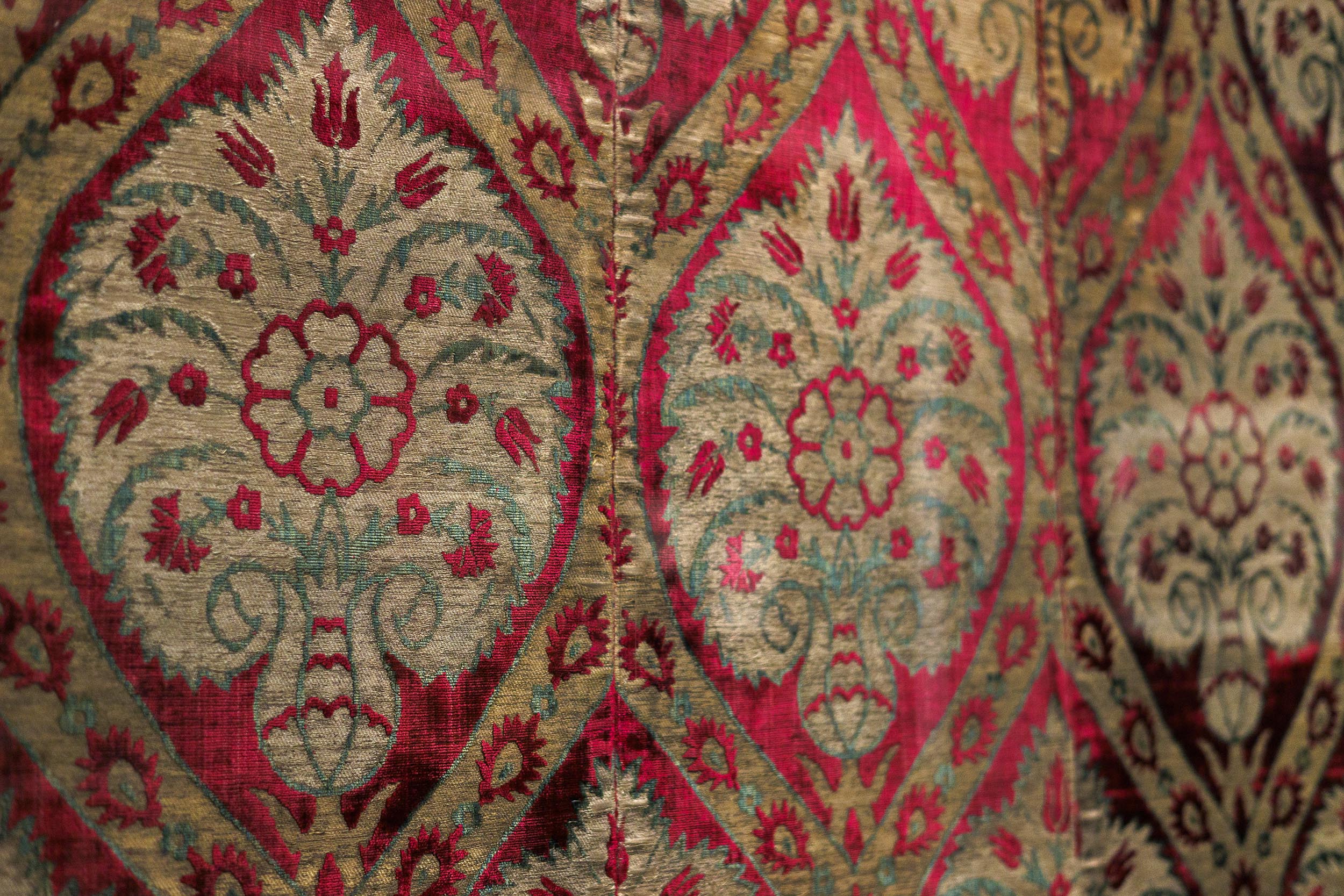
Close-up of “Velvet with Tulips and Carnations in Ogival Lattice.”
Stephanie Mitchell/Harvard Staff Photographer
Dressed to impress
In the Ottoman Empire, both men and women wore kaftans, robes that were often handed down to family members and servants, at which point they often were altered to fit the new owner. Schepers points out cinching at the waist of the purple silk satin kaftan on display, as well as its gold and silver metallic swaying vine motif.
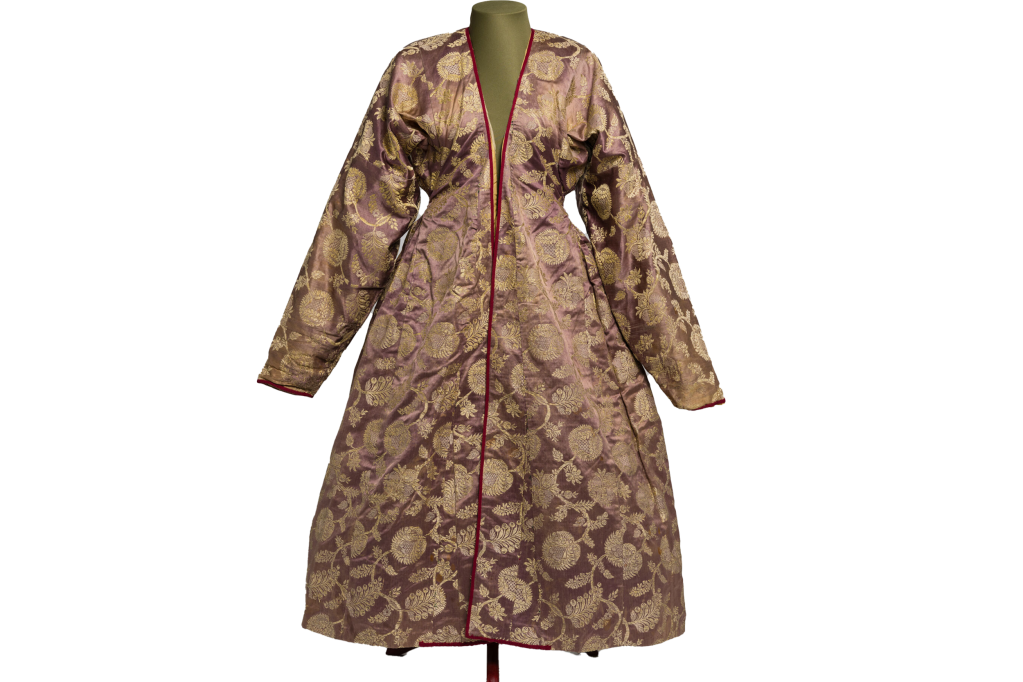
Robe decorated with swaying vine motif, 18th–19th century.
Arthur M. Sackler Museum
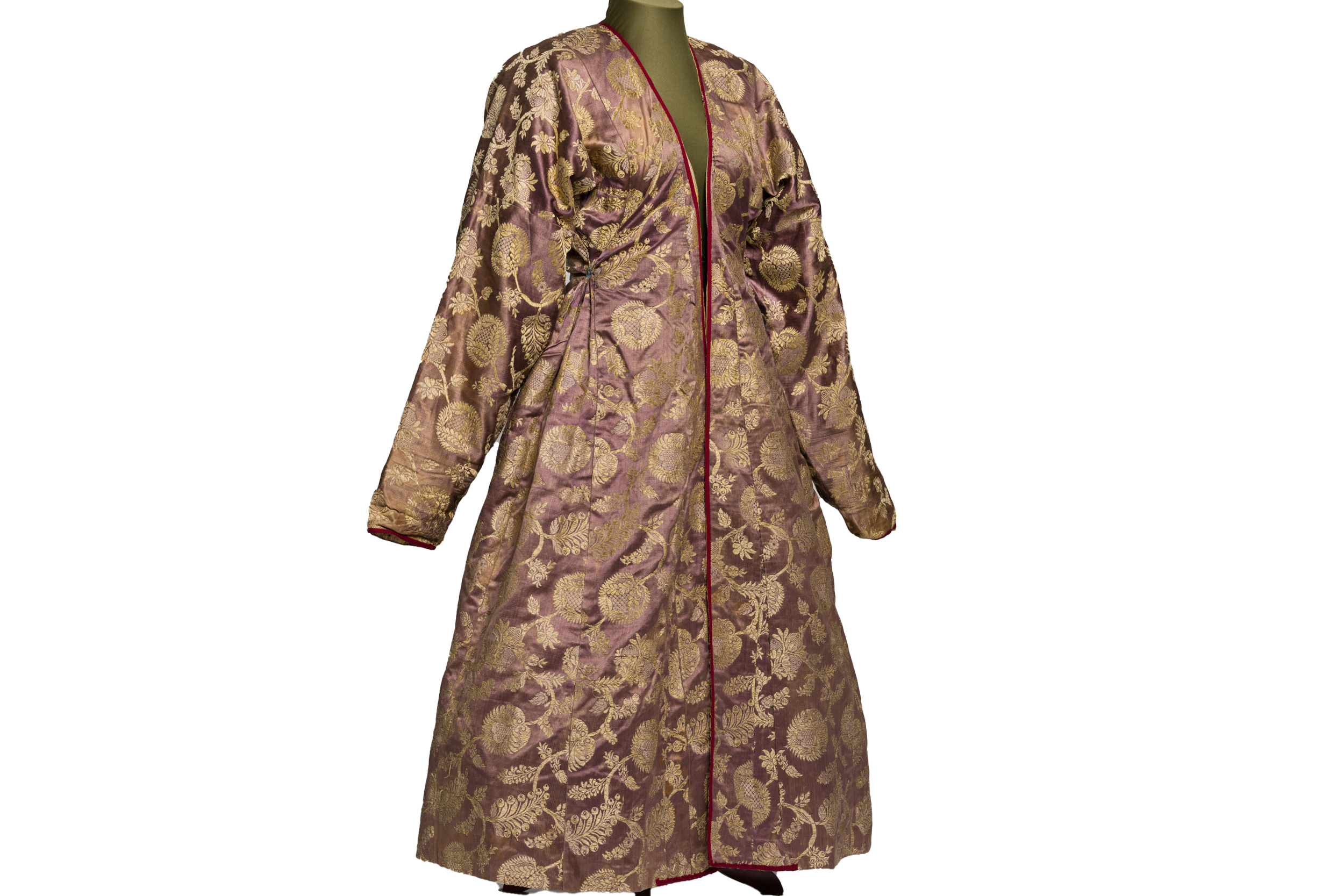
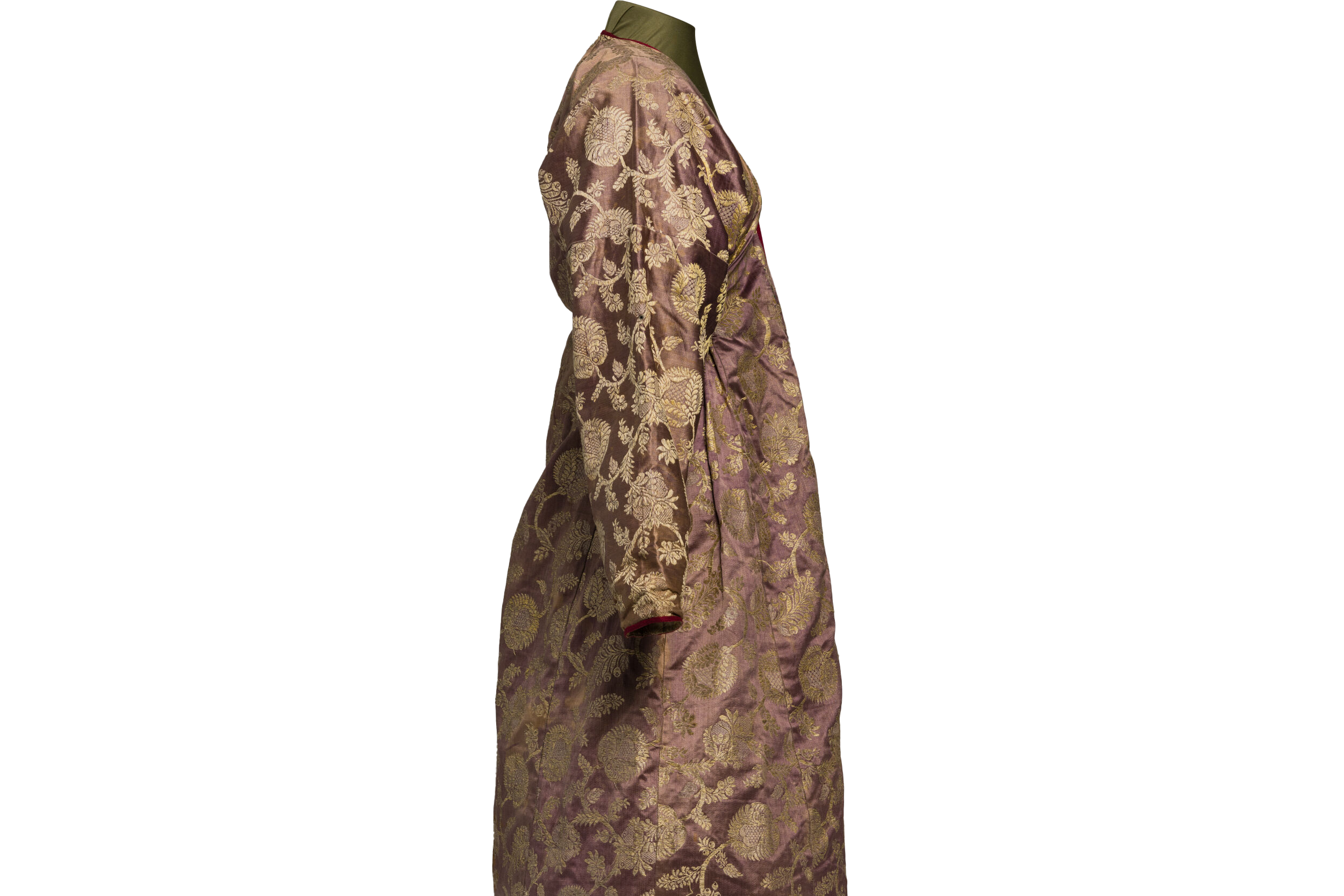
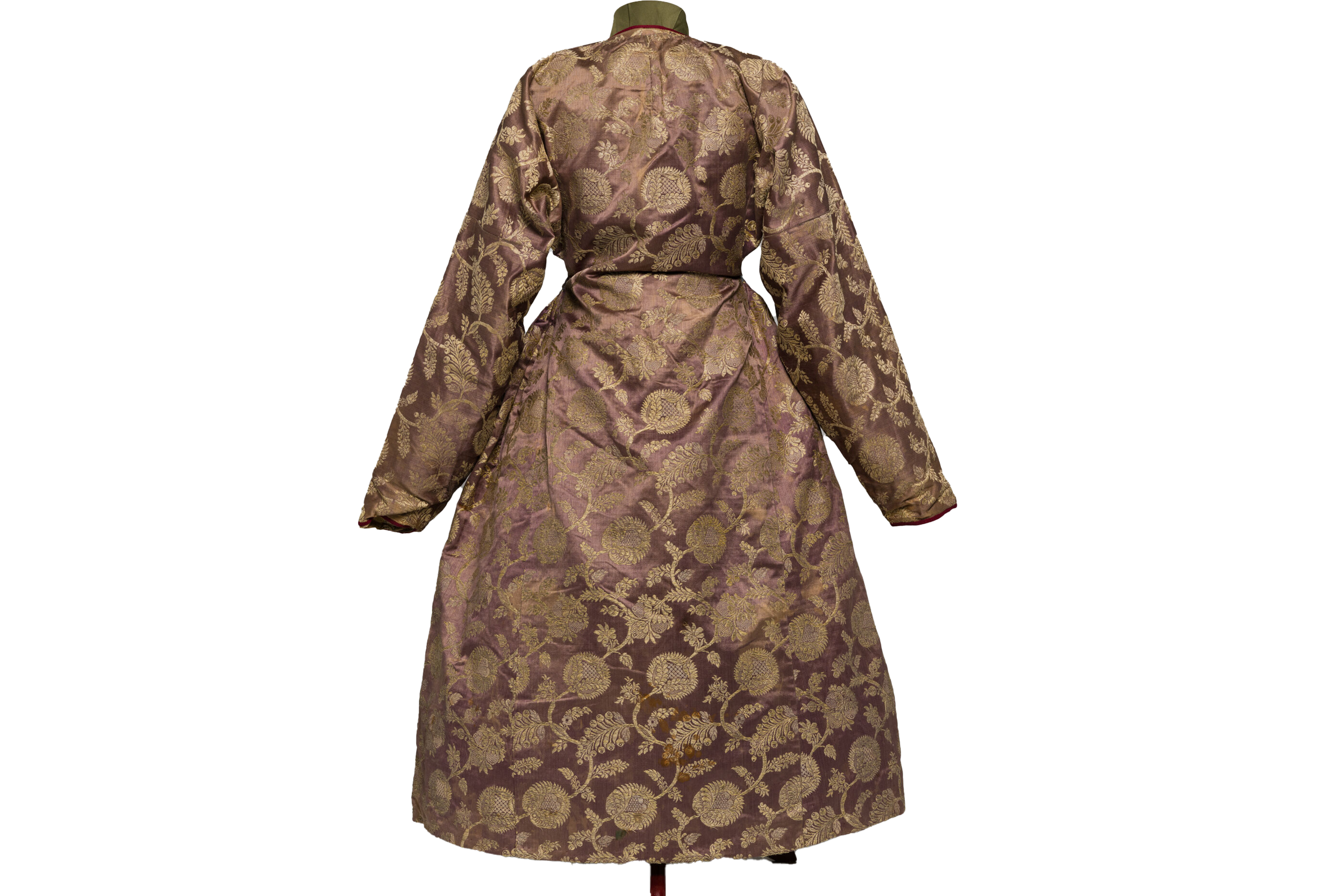
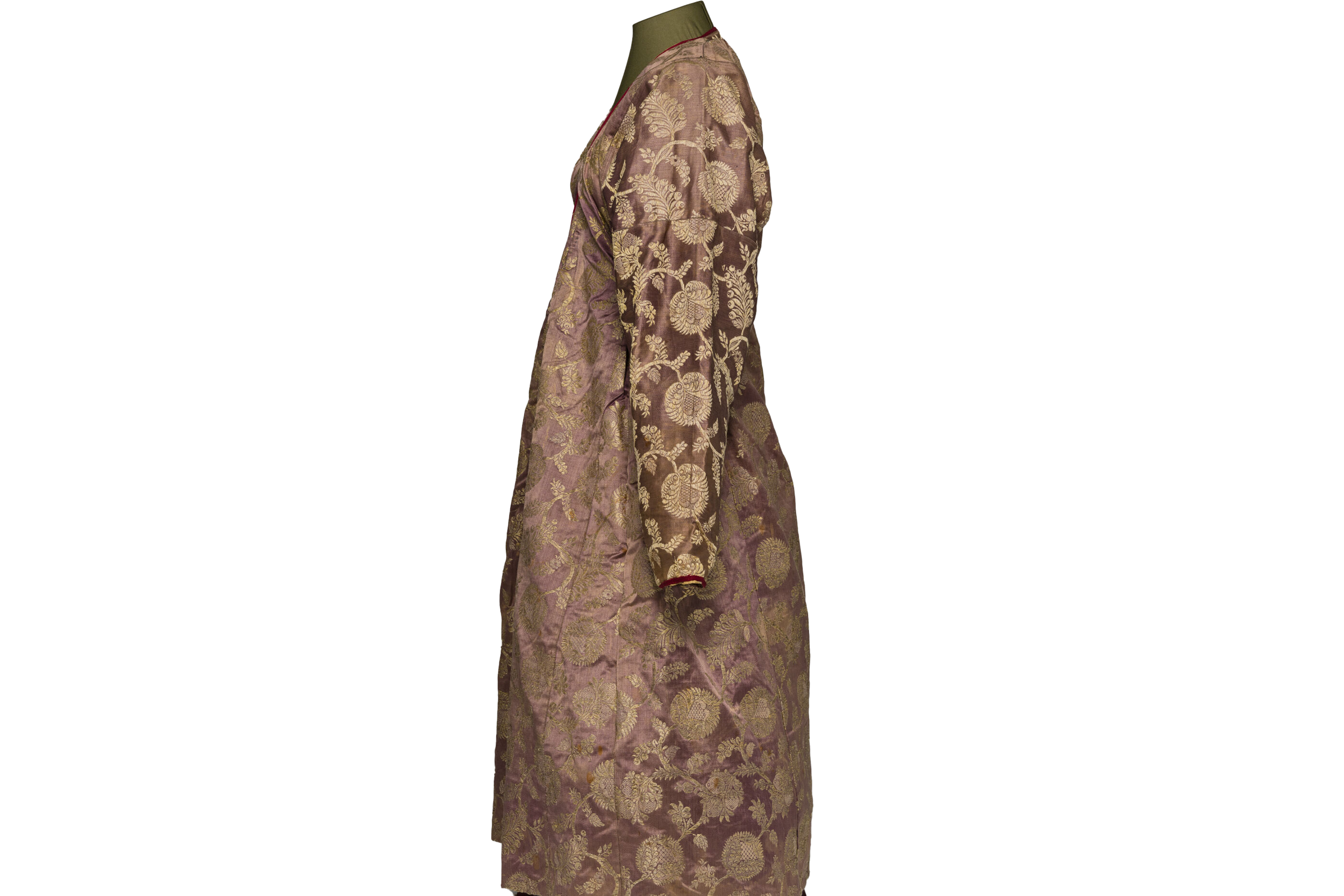
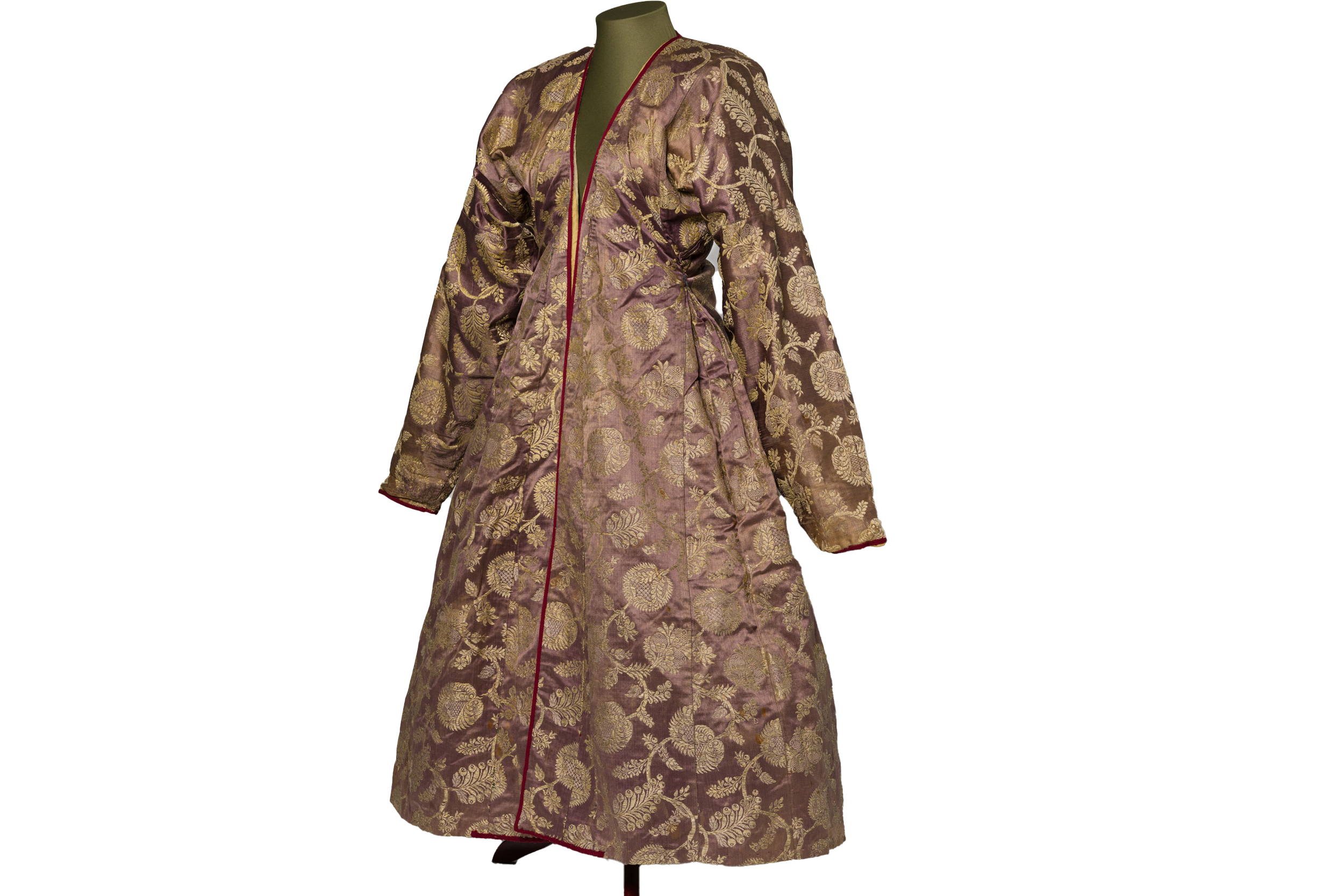
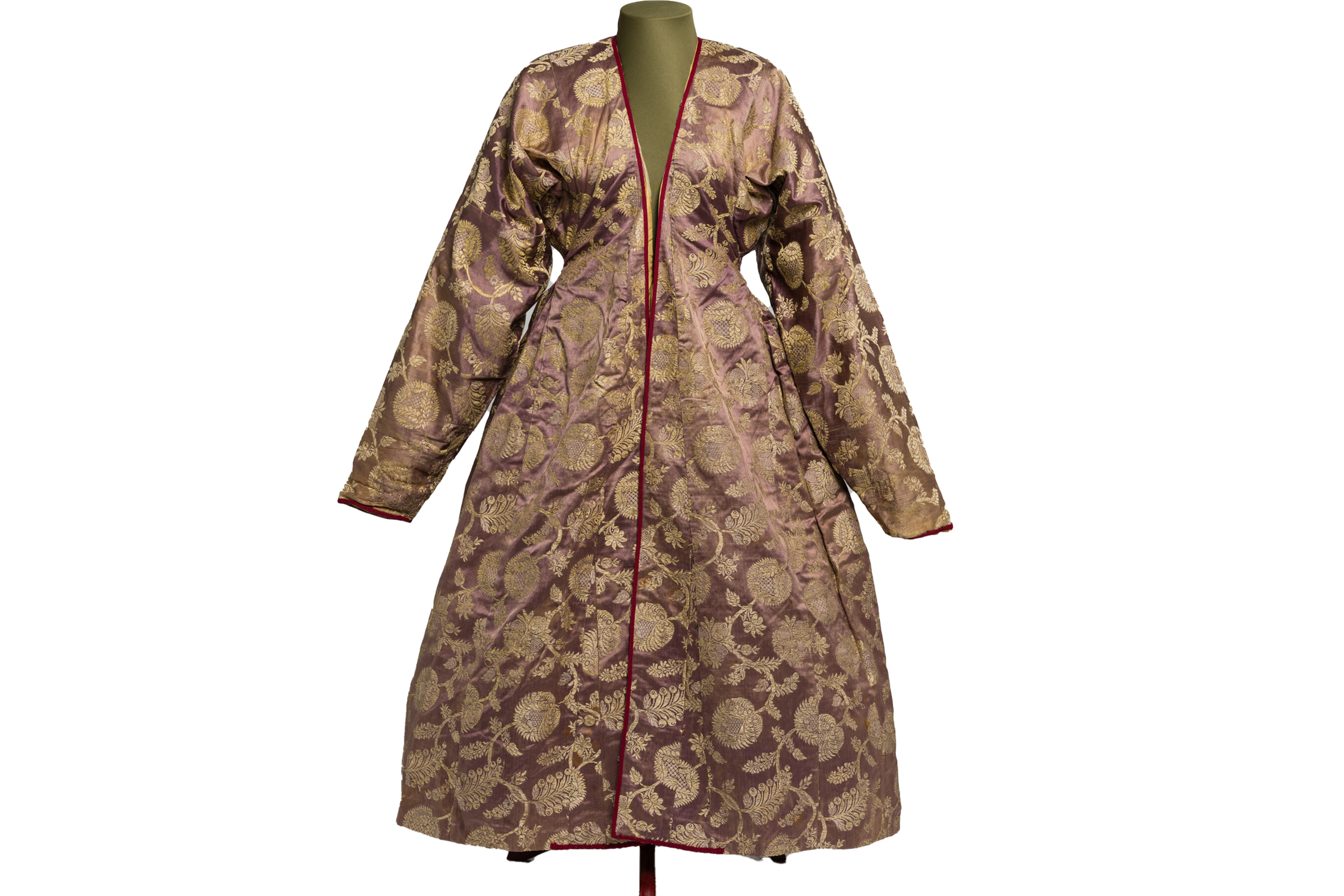
Arthur M. Sackler Museum
Though luxurious, she said, the kaftan was meant to be used. “I love that you can see the wear and tear. You can see some staining from sweat.”
It’s hard to believe the nalıns, or bath shoes, in a case nearby with their tall wooden platform heels inlaid with mother of pearl were ever worn, but Schepers notes use on the leather straps.
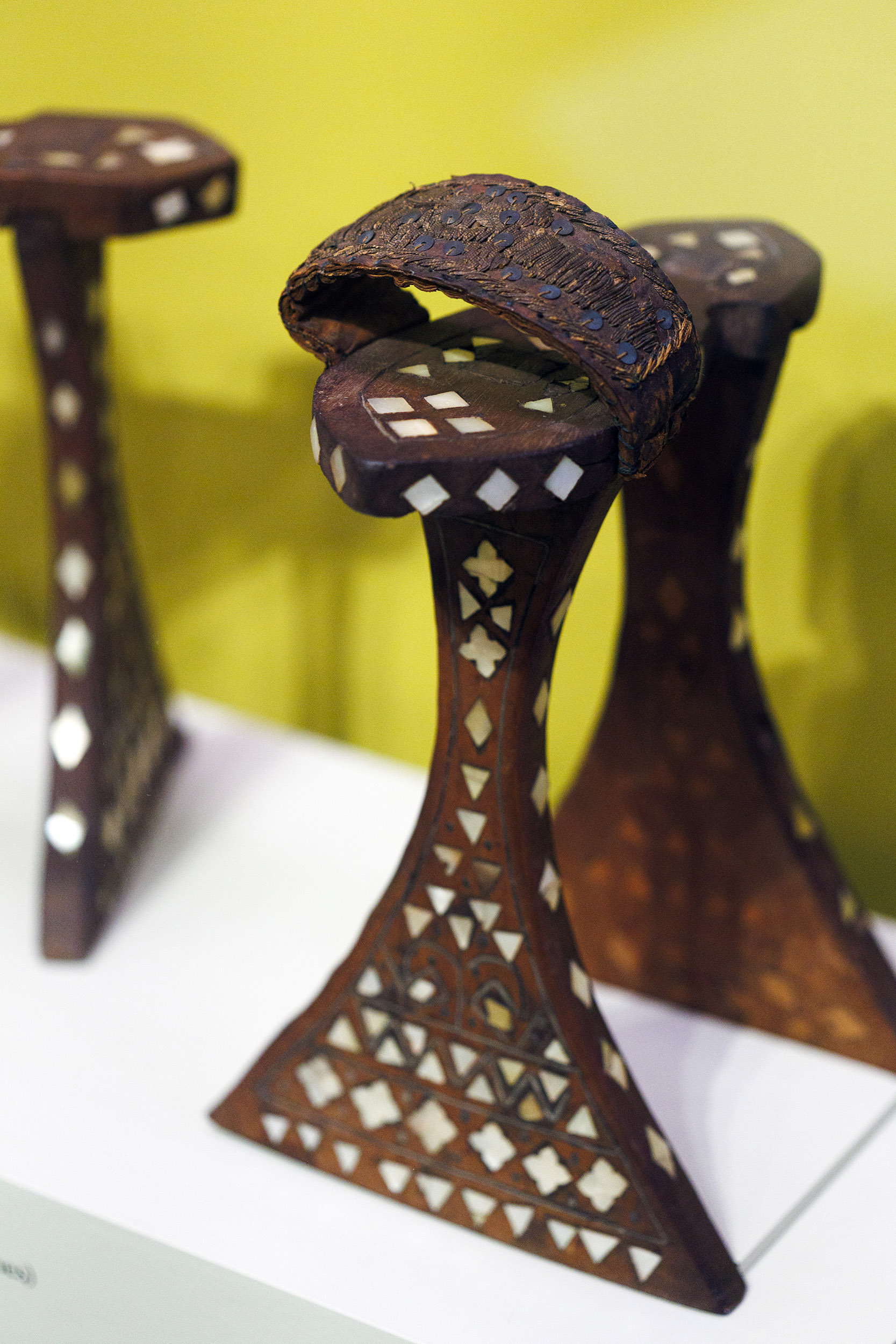
Pair of nalıns (bath shoes), 19th century.
Stephanie Mitchell/Harvard Staff Photographer
“The height of the shoes is a status symbol. The higher you are, the more important you are because you need servants who could hold you while you were walking. The higher the heels, the more servants you need.”
Clues in crosshatches and ‘Habsburg jaw’


“Charles V,” by Barthel Beham, 1531 (left) and “Portrait of Charles V, Holy Roman Emperor,” Haydar Reis, 1566–74. Fogg Museum; Arthur M. Sackler Museum
“To the left we have a portrait by German artist Barthel Beham and to the right we have one from Ottoman artist Haydar Reis, and when you look at this you immediately see similarities between both,” said Schepers. “You can see the same type of fur coat, you can see the same type of hat, the beard.
“This is not a one-to-one copy but we know that Haydar Reis, before he became a court artist, he was also a sea captain who would have had access to European prints of Charles V both when he was stationed in the Mediterranean and at the Ottoman court in Istanbul.
“When you look closely you can see how his face is painted. It looks as if the artist used crosshatching, which is a technique you see in printmaking. It’s not a painter’s technique. So we’re pretty sure that he used a print as an example.
“What I really love about this is that you can encounter a different culture, but you never really get to the nuances. Charles V, because of all the Habsburg inbreeding, couldn’t close his mouth physically, it was always a little bit open. In the Netherlandish tradition of lifelikeness we show him with his mouth open but the Ottoman artist has closed his mouth because it’s polite. It’s such a tiny detail but for me this is glorious.”
Rugs to riches
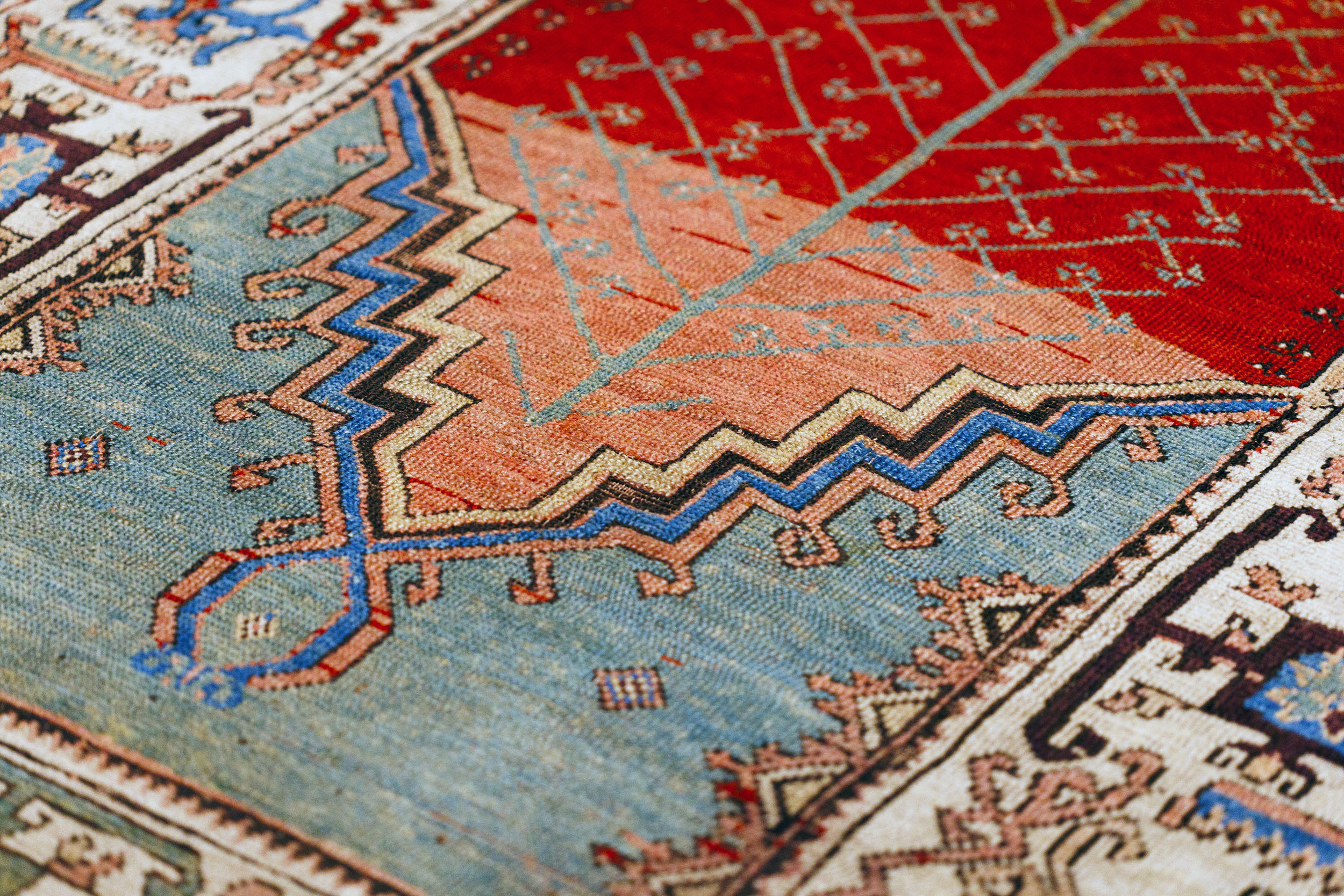
Prayer carpet detail, 1850-1900.
Stephanie Mitchell/Harvard Staff Photographer
A prayer carpet lying flat on the floor positioned in the direction of Mecca is juxtaposed with an Ottoman carpet draped over a Dutch-style table.
“Once these carpets in the 17th century were imported to the Low Countries, they were luxury objects. They were no longer used to pray; they were used to show off your wealth and your access to the trade market. You would either hang them on a wall or drape them over a balcony or a table,” Schepers said.
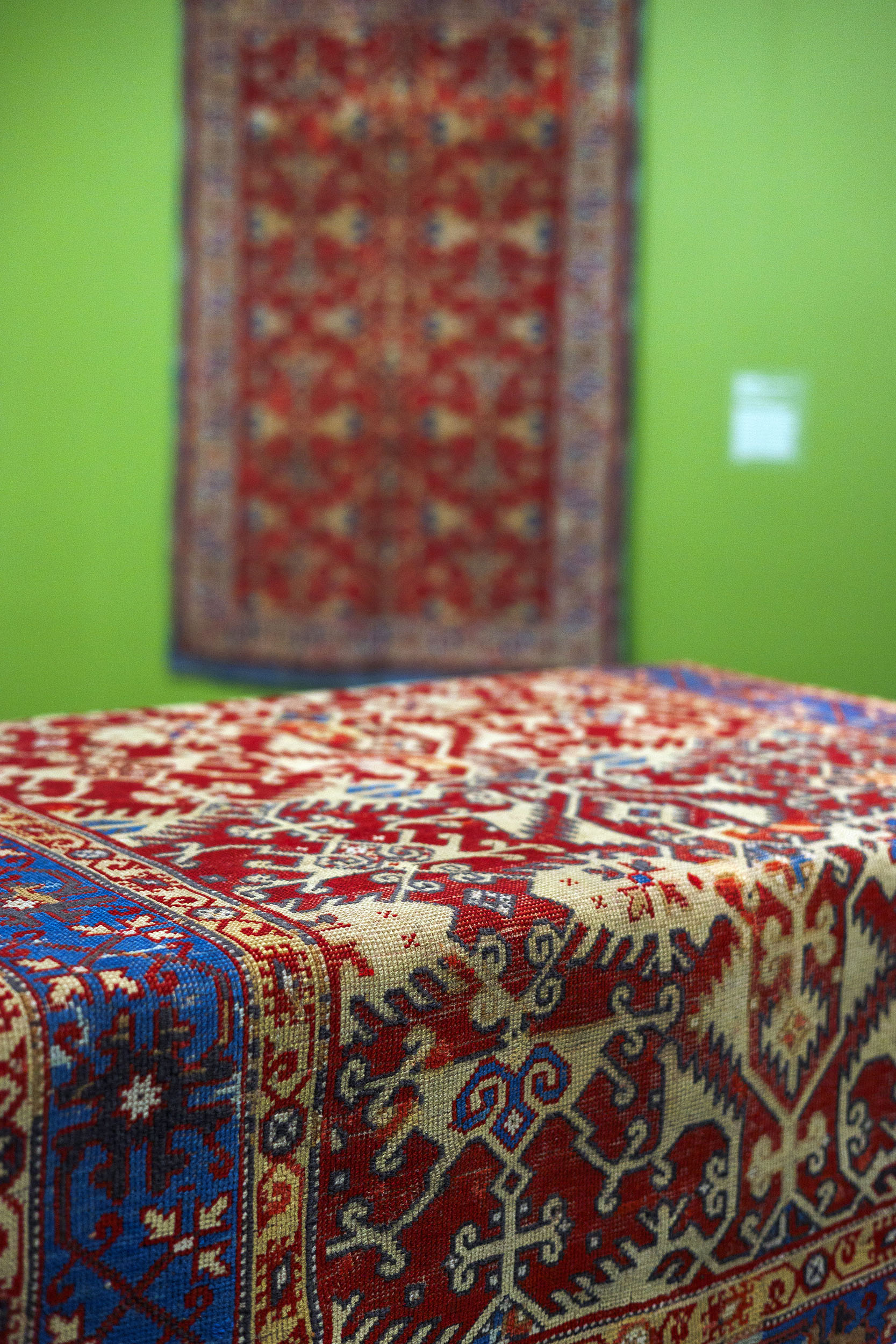
Lotto carpet draped over Dutch-style table.
Stephanie Mitchell/Harvard Staff Photographer
Research and teaching
“This is a section I’m very proud of because I wanted students and fellows, conservation fellows, museum fellows, to all get involved with this exhibition,” Schepers said about a portion of the exhibit that highlights teaching and ongoing research. She added: “I also want to give them real exhibition practice, so all of the labels here are written by students.”
She called out a label written by Shireen Shah of the Harvard Kenneth C. Griffin Graduate School of Arts and Sciences.
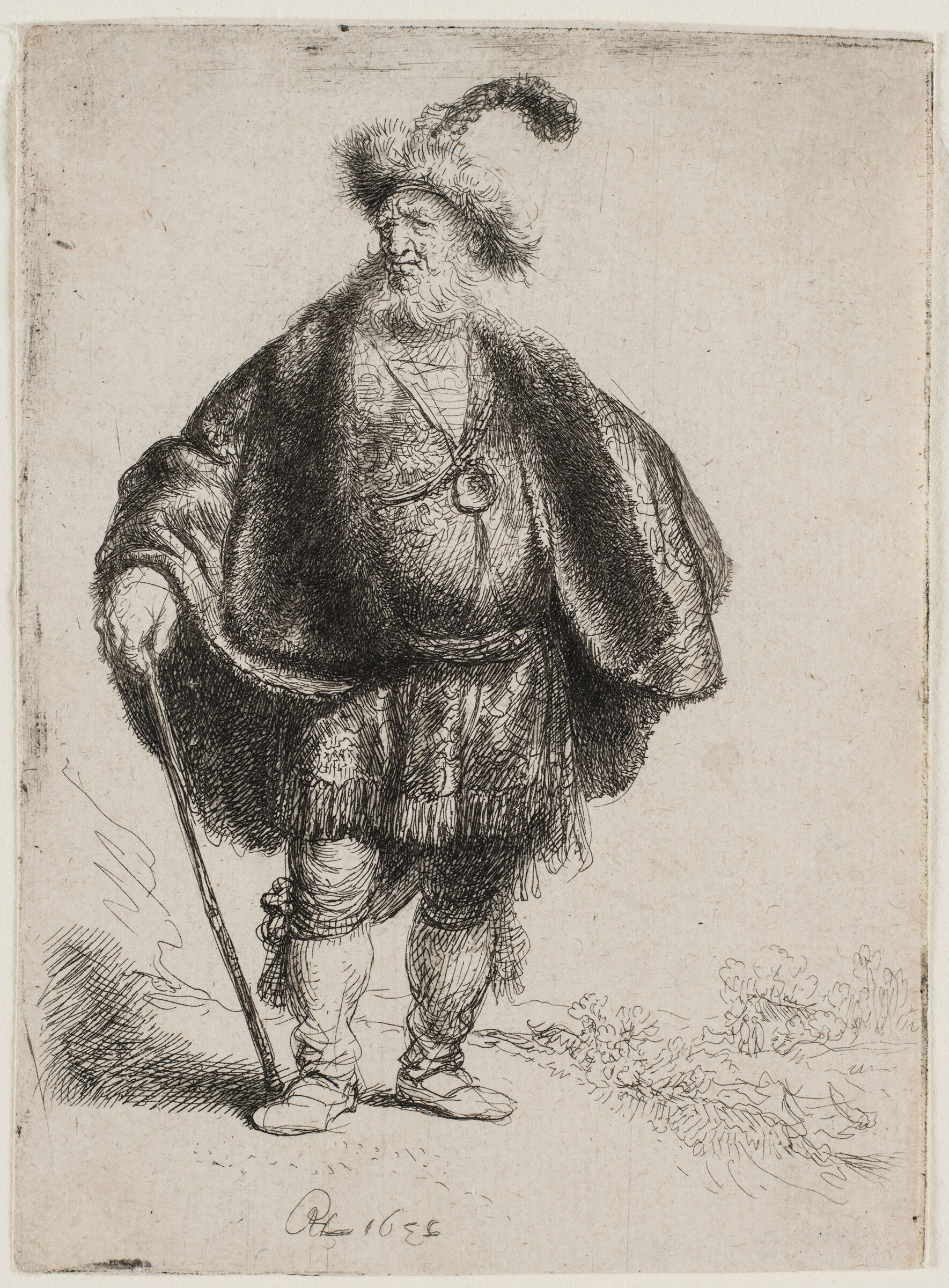
“The Persian,” Rembrandt Harmensz. van Rijn, 1632.
Fogg Museum
“Rembrandt’s understated yet effective hatching technique beautifully captures the range of textures in this man’s clothing. His heavy coat, soft fur cap, worn boots, and stiff cane immediately call their associated scents, sounds, and textures to mind: imagine the crunch of his cane against the rocky ground, the smell of leather emanating from his boots, the warmth of his woolly coat. The feather in his cap is reminiscent of the black egret plumes that adorned the turbans of Safavid royalty and nobility, hence his title ‘the Persian.’ Despite the exquisite rendering of his costume, the figure’s identity is unknown.”
Drawing from the museums’ extensive Forbes Collection of Pigments, Schepers and Celia Chari, Beal Family Postgraduate Fellow in Conservation Science, were able to showcase, in a glass case, samples of paint colors used in the works in the exhibition.
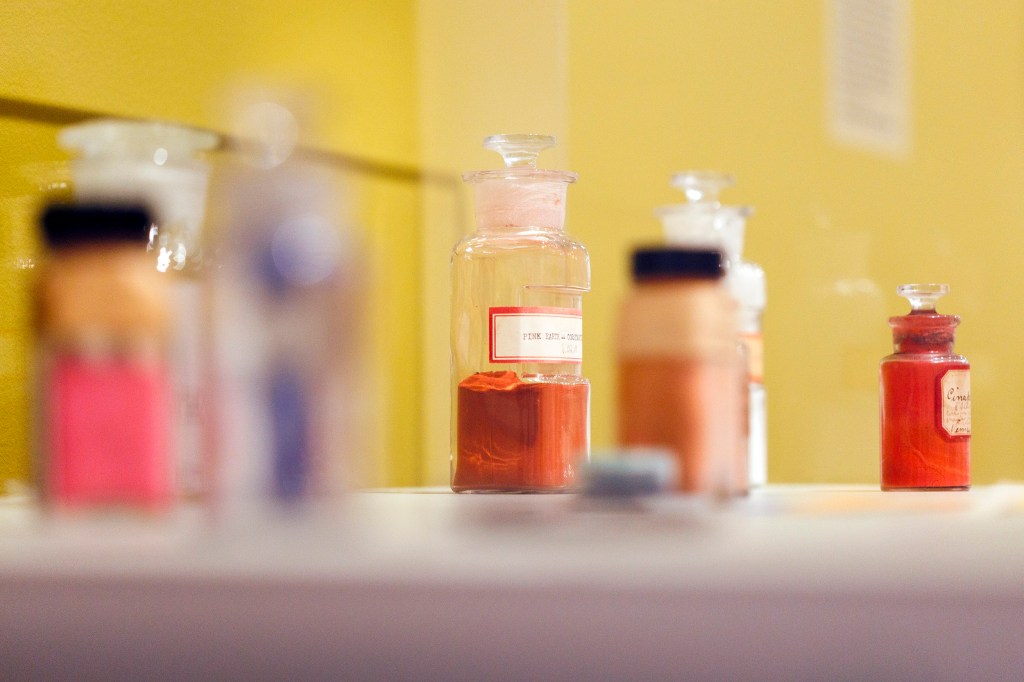
Display of pigments found in the exhibition.
Stephanie Mitchell/Harvard Staff Photographer
The cabinet includes an in-situ experiment to better understand the impact of lighting conditions in a gallery setting. Chari wondered whether Reis, in his portrait of Francis I, deliberately used a rare, mineral-based yellow pigment called pararealgar, which turns red eventually as it is exposed to light, for the golden areas of the painting.
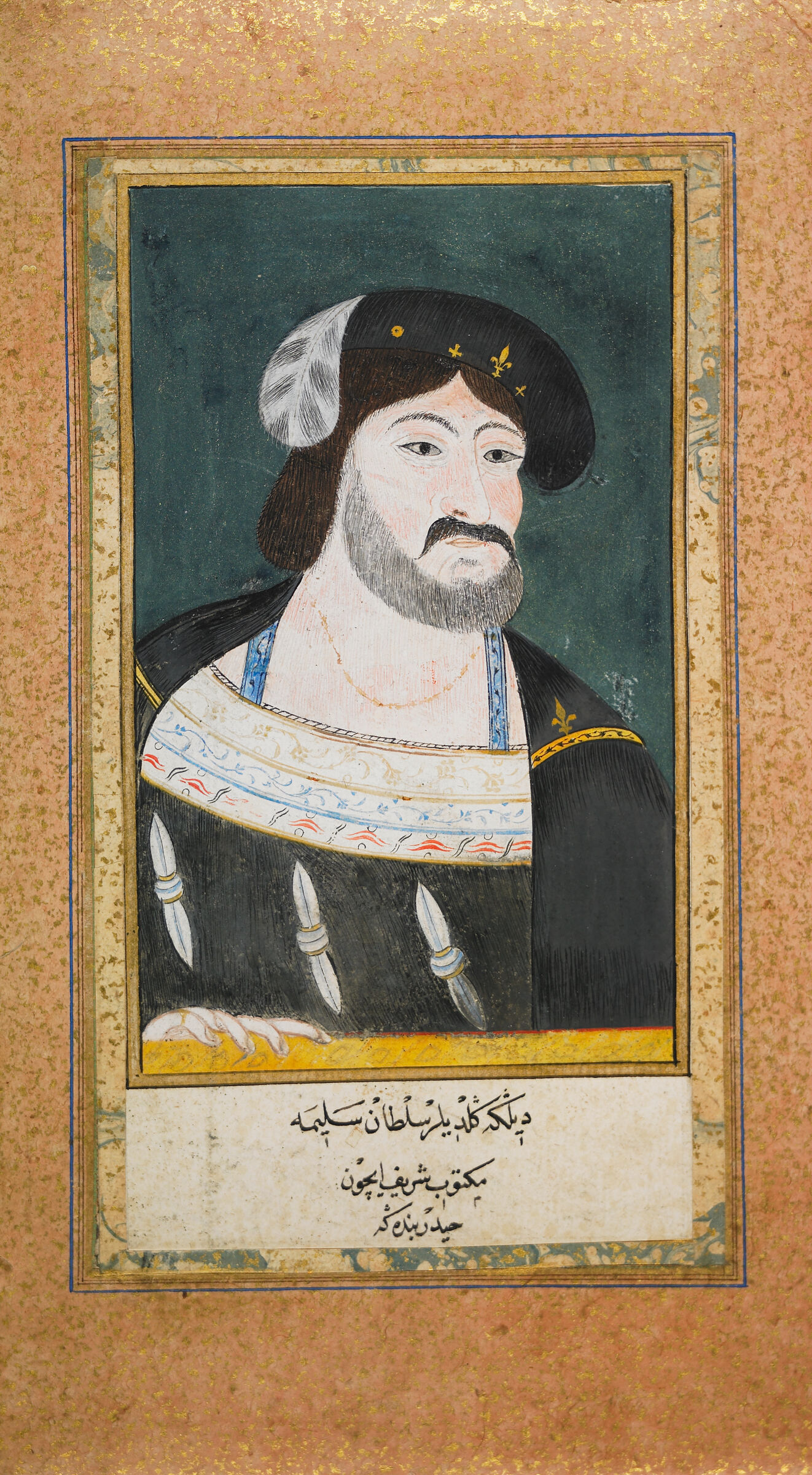
“Portrait of Francis I, King of France,” Haydar Reis, 1566–74.
Arthur M. Sackler Museum
Chari is monitoring paint-outs in the cabinet of natural realgar, heat-treated realgar, artificial realgar, pararealgar, and orpiment, comparing how the swatches change over time under gallery lights. This also will help museum staff better understand how long they can safely display works composed of those materials.


